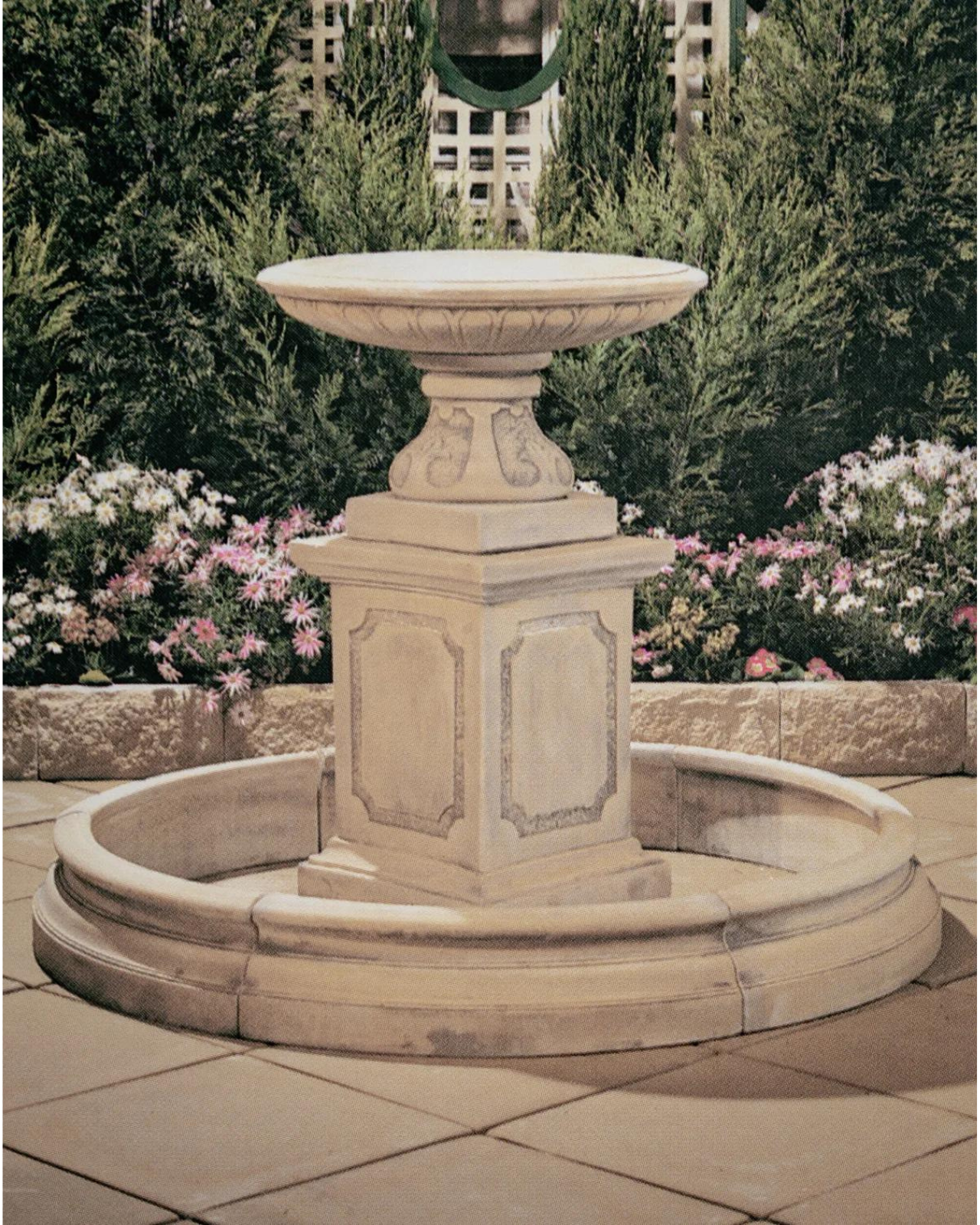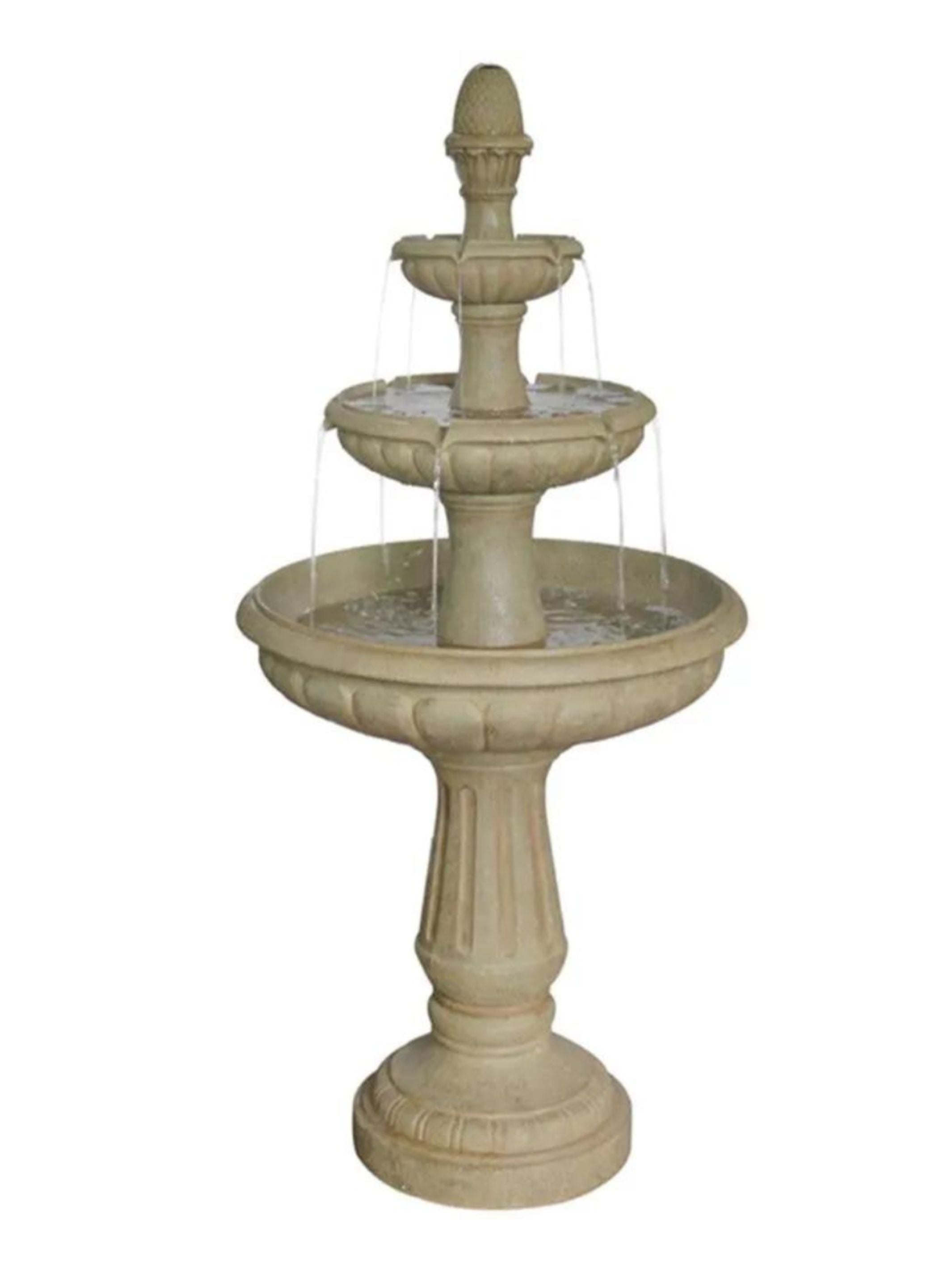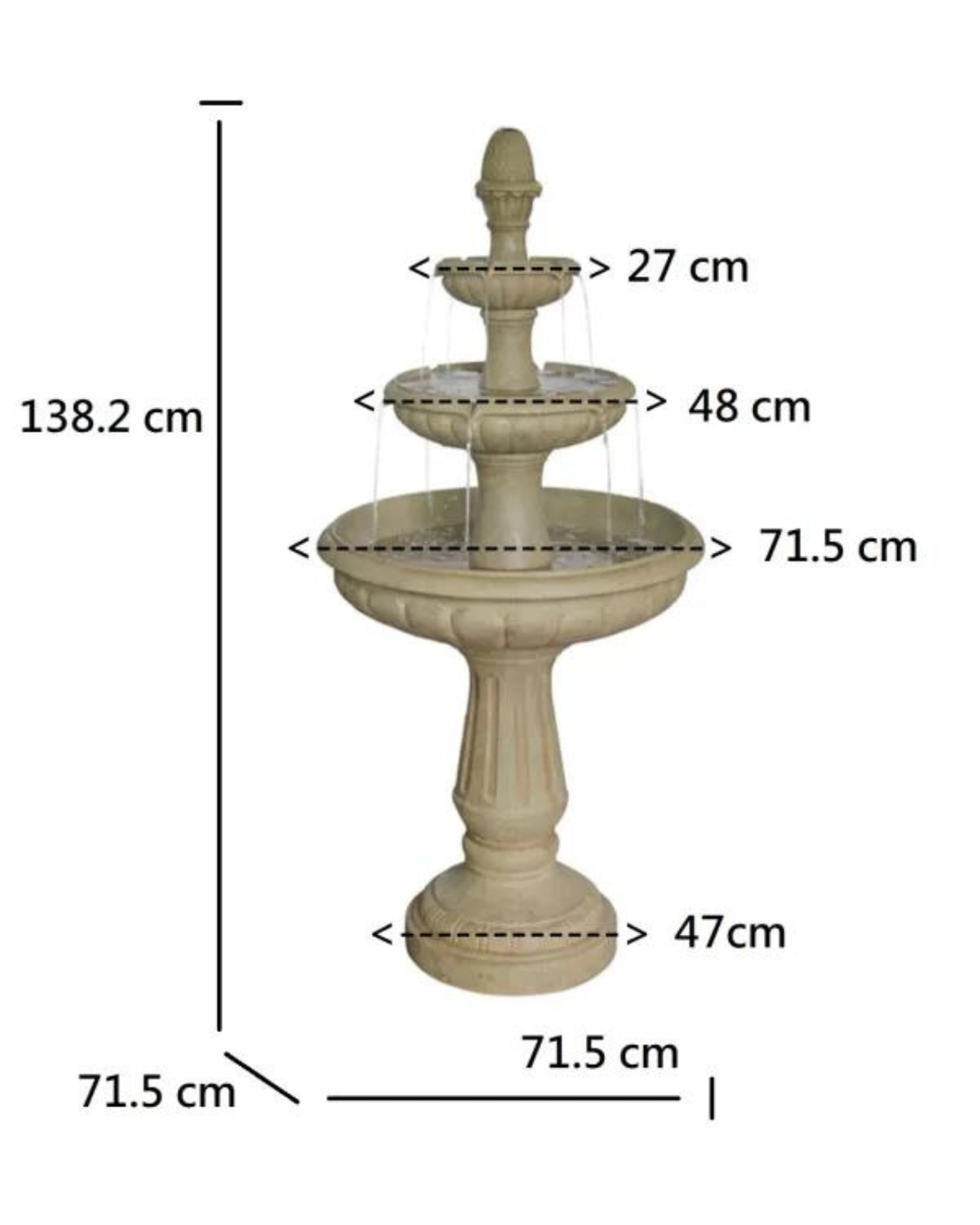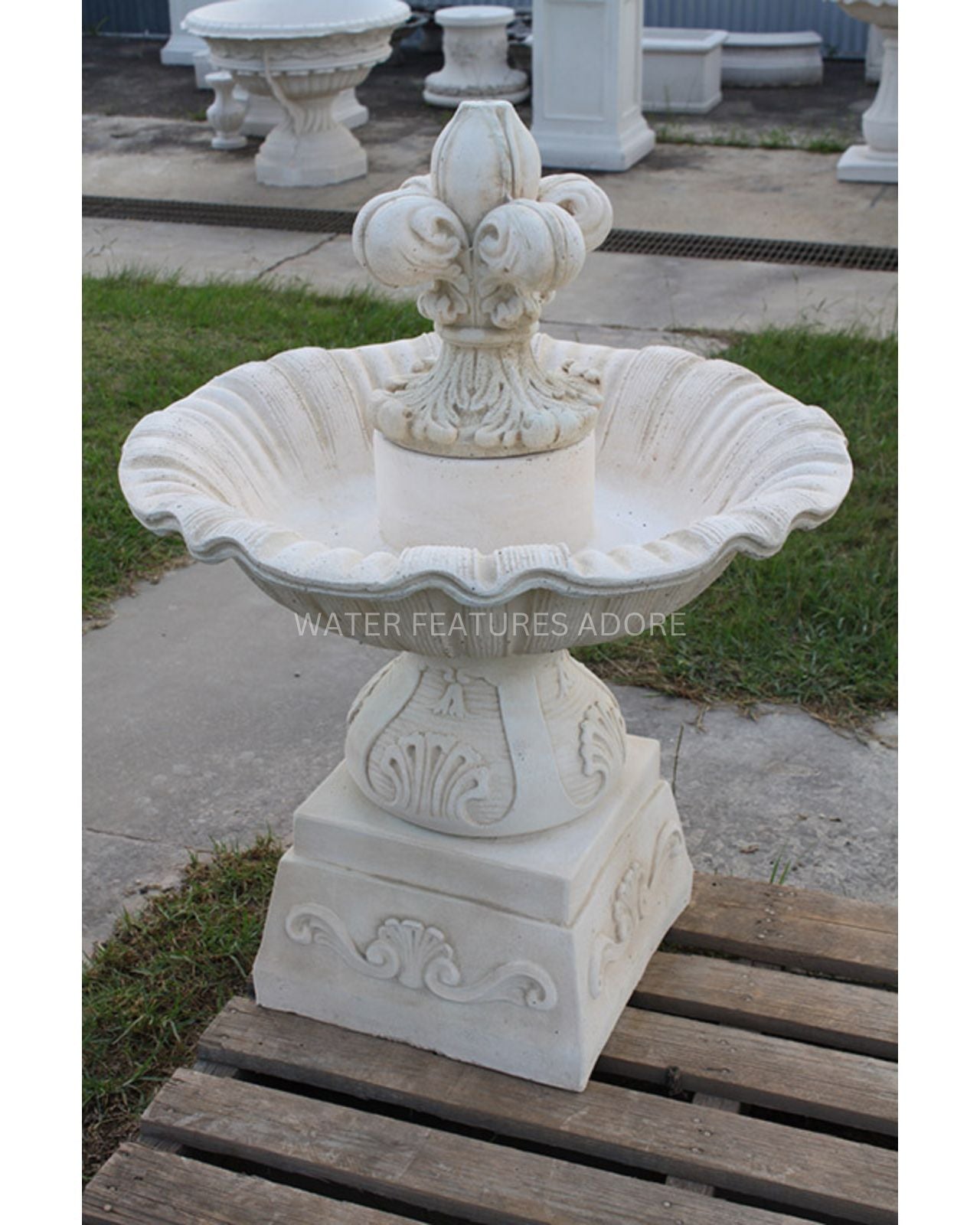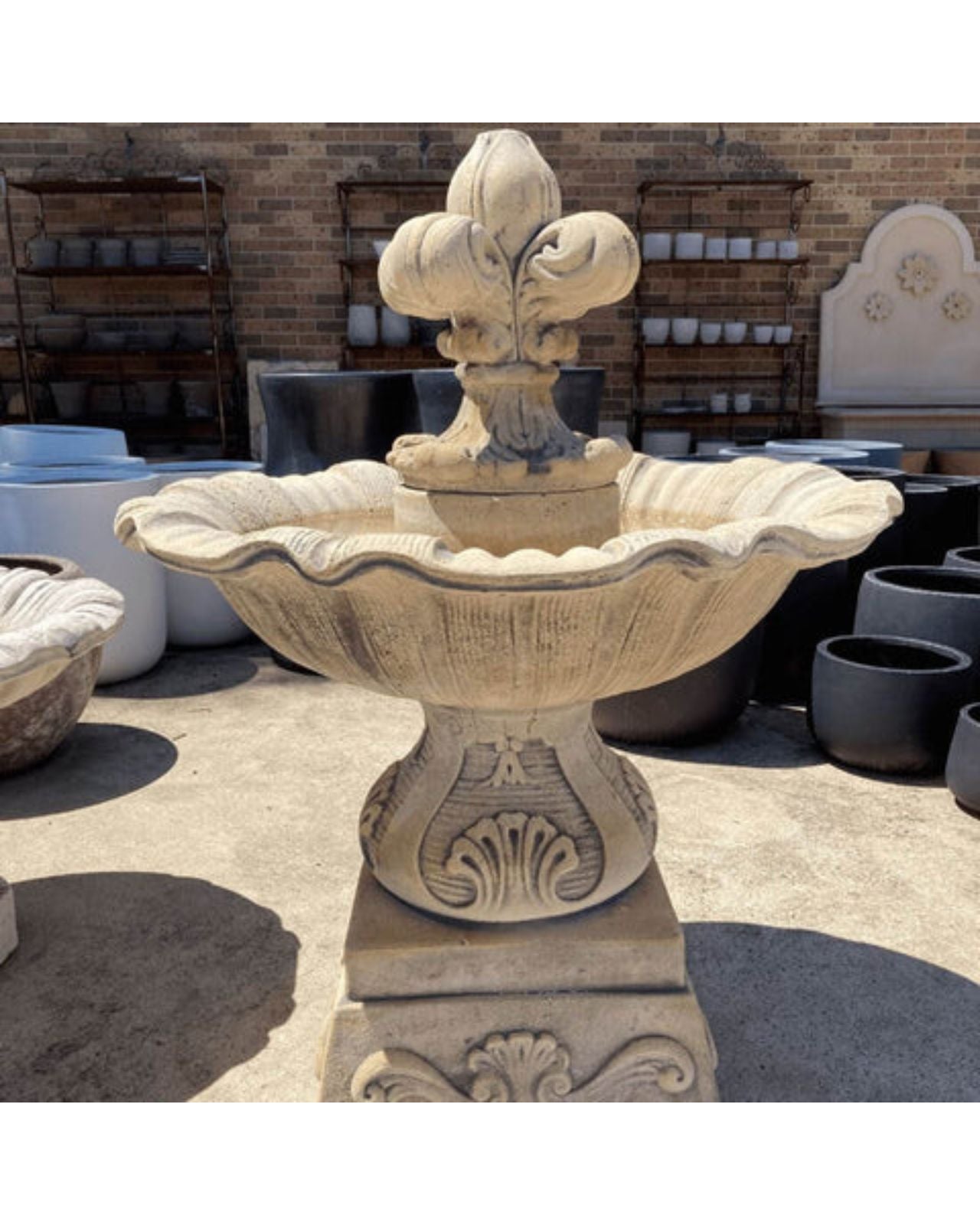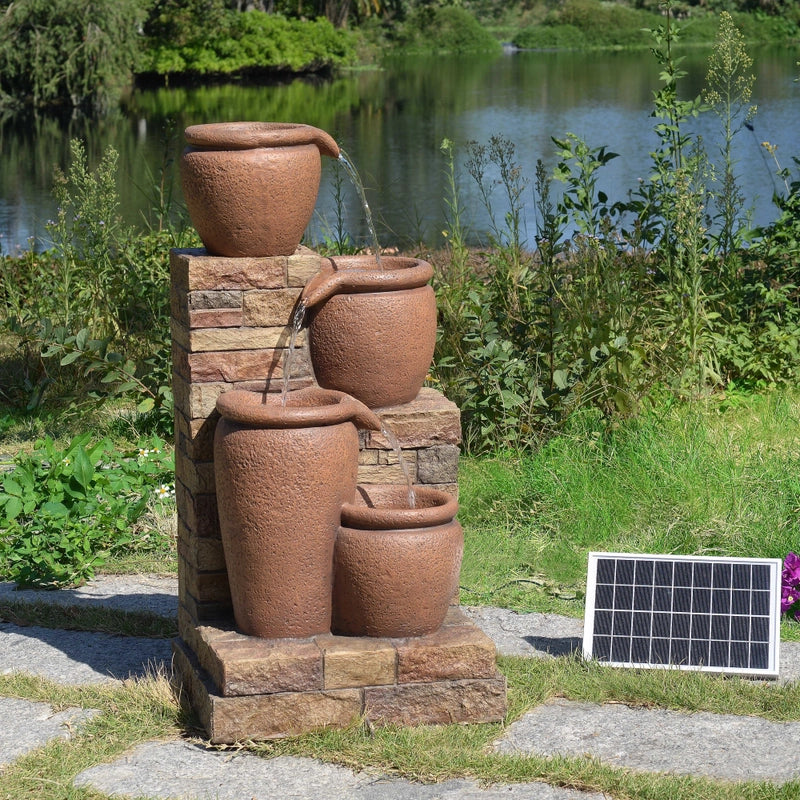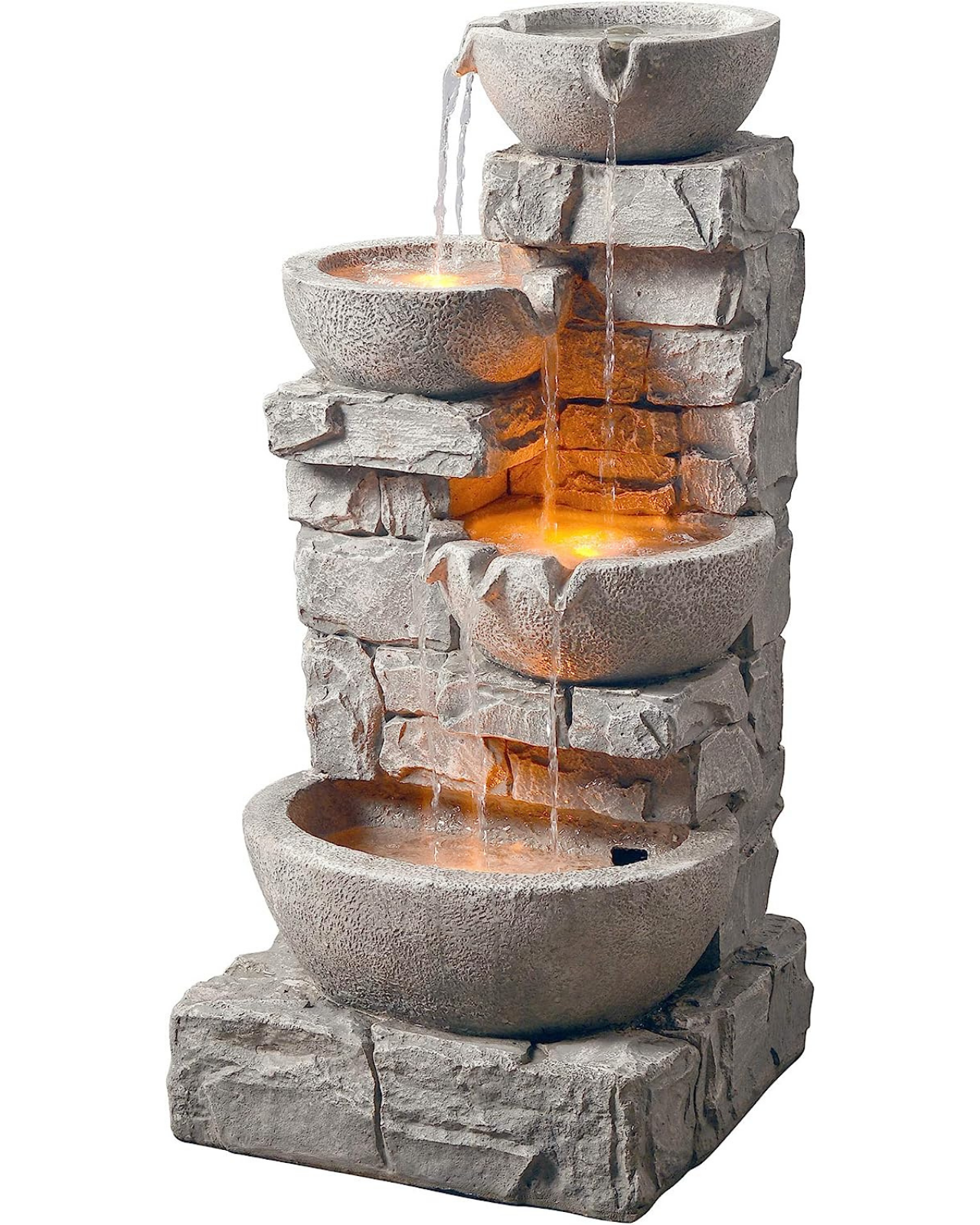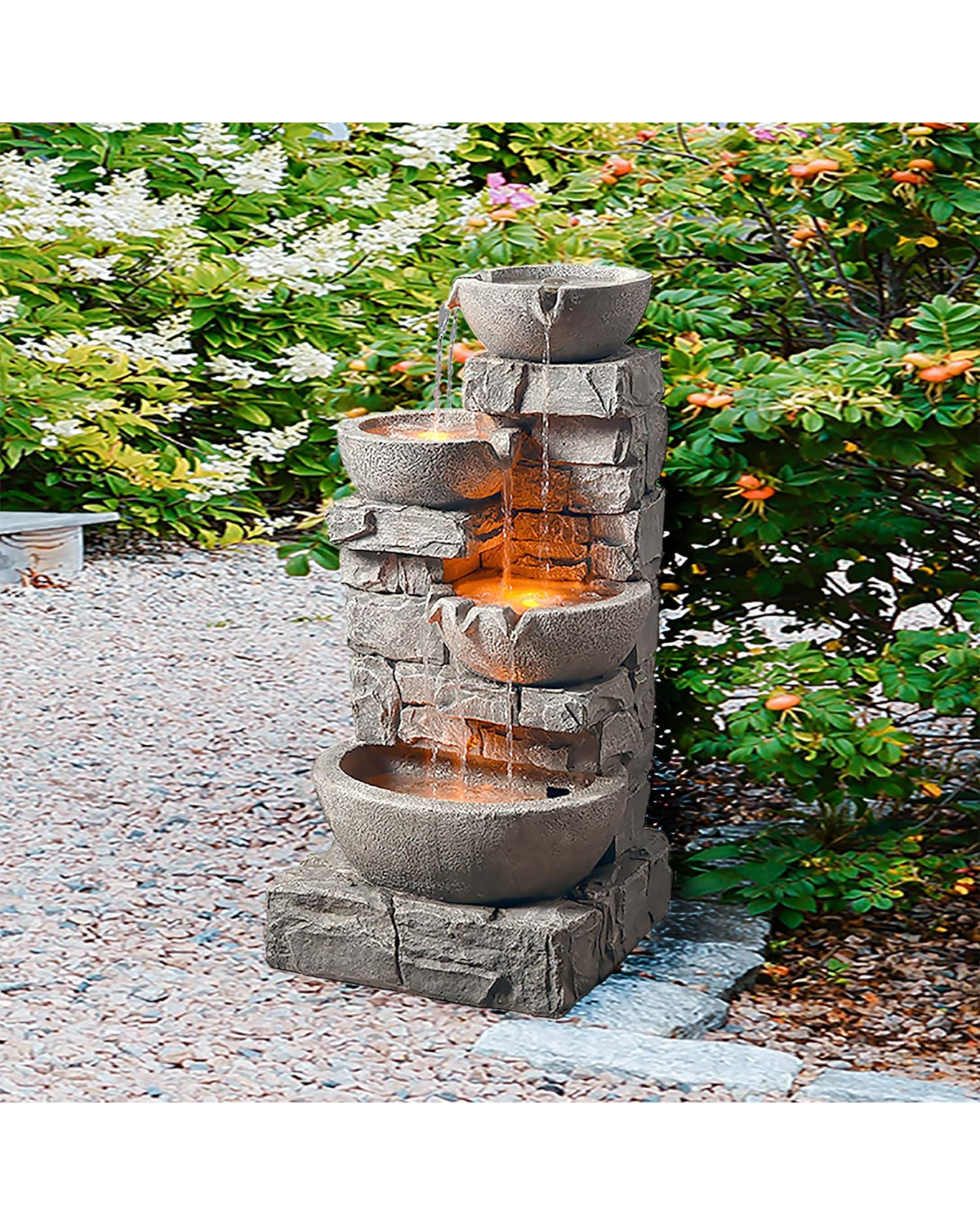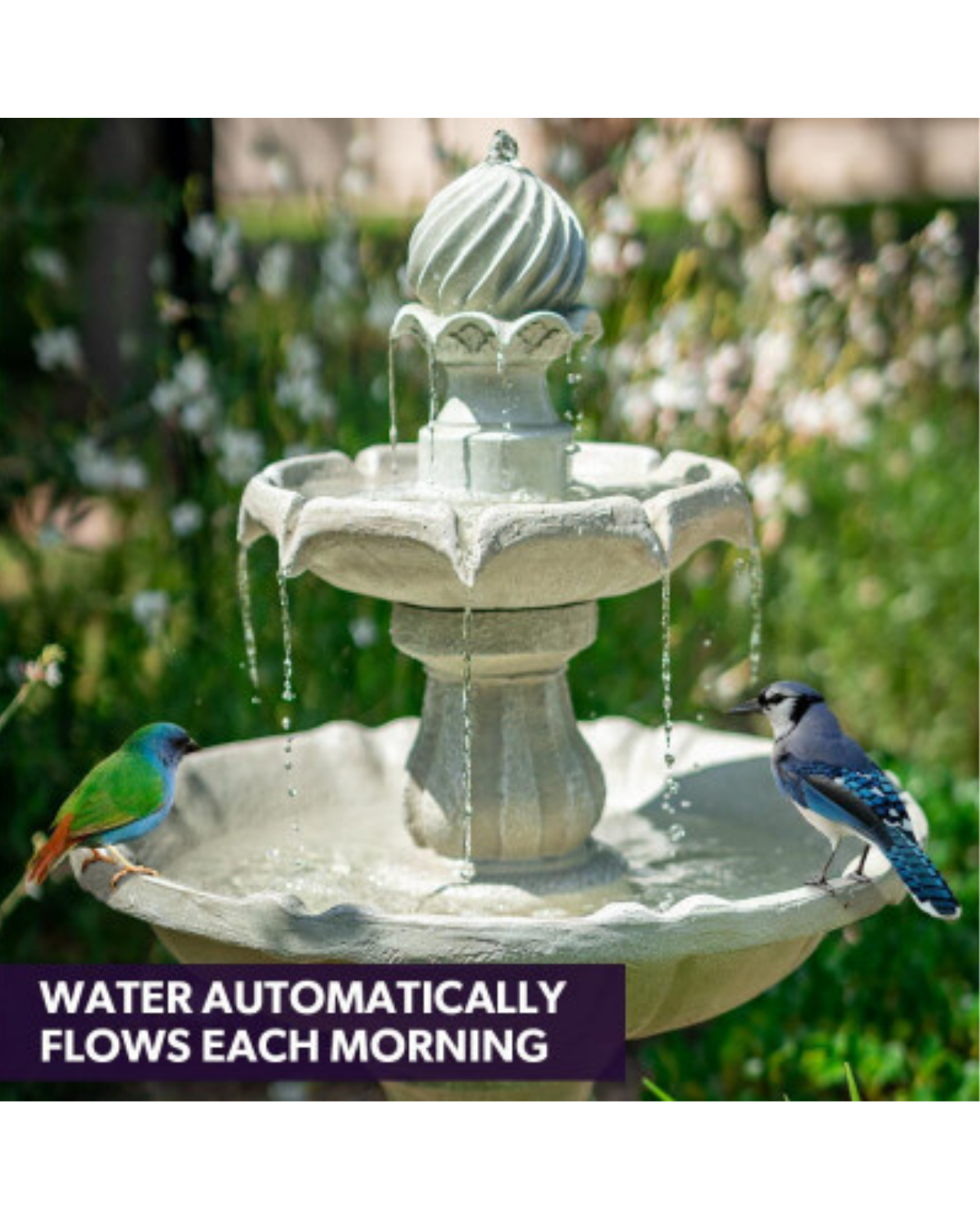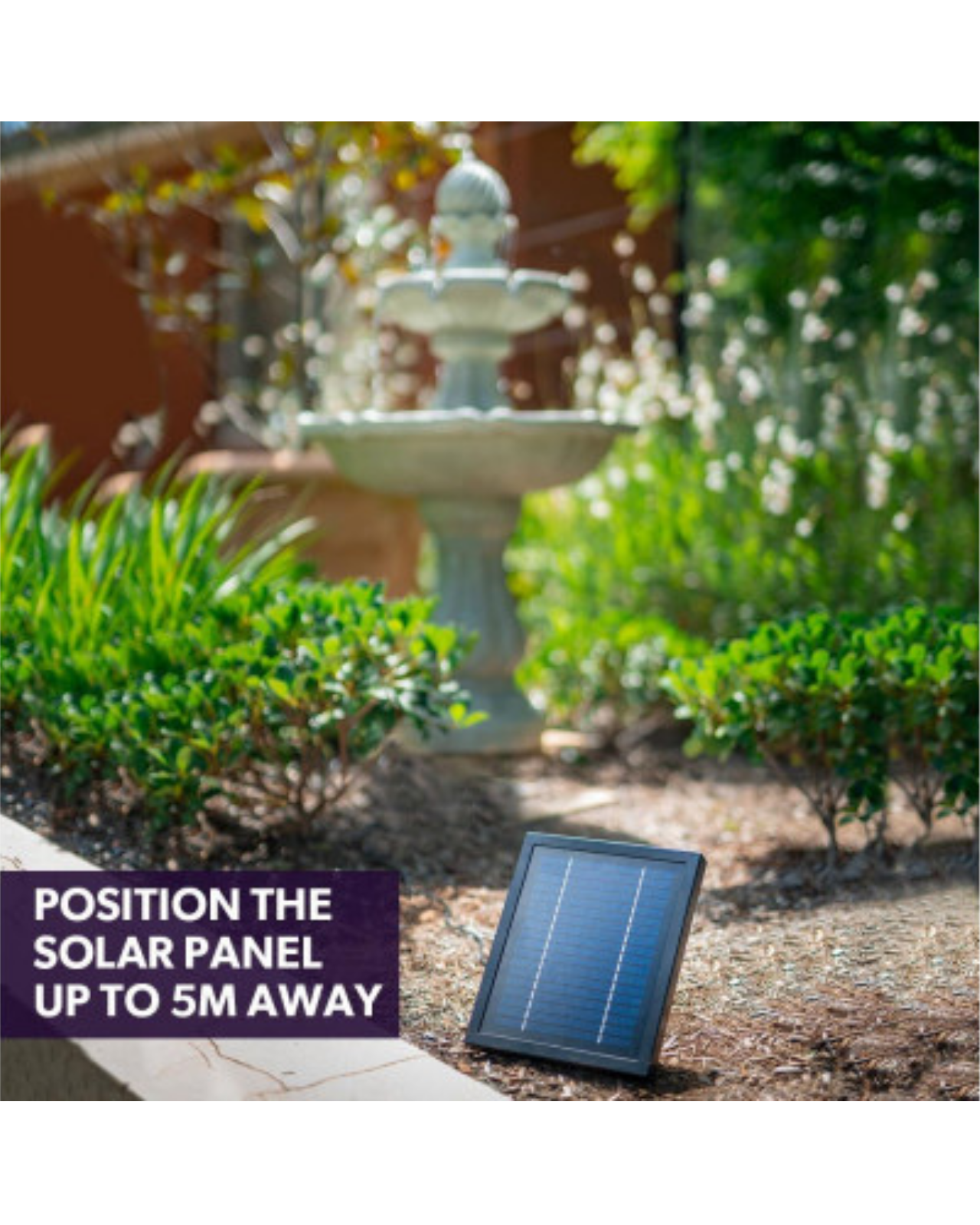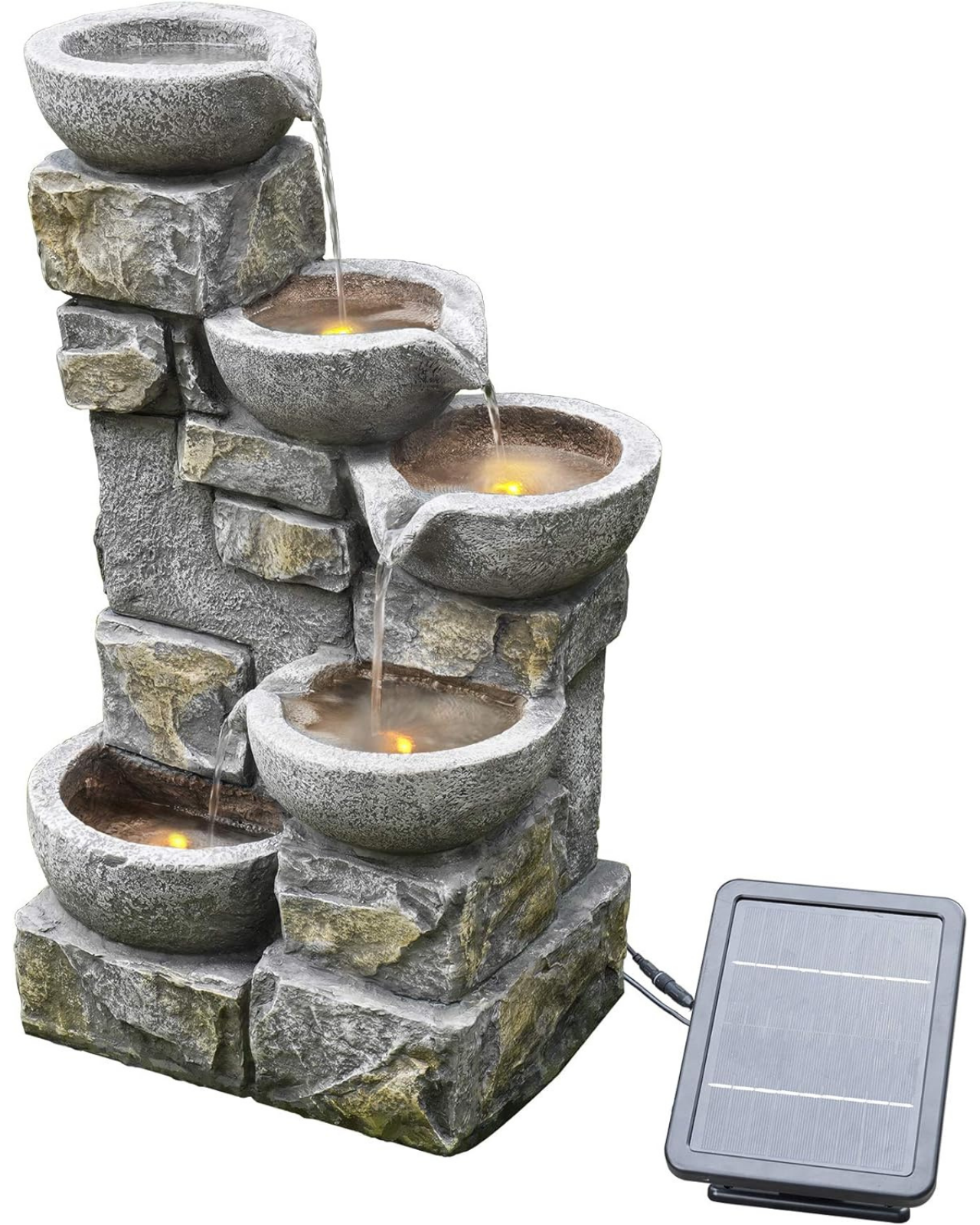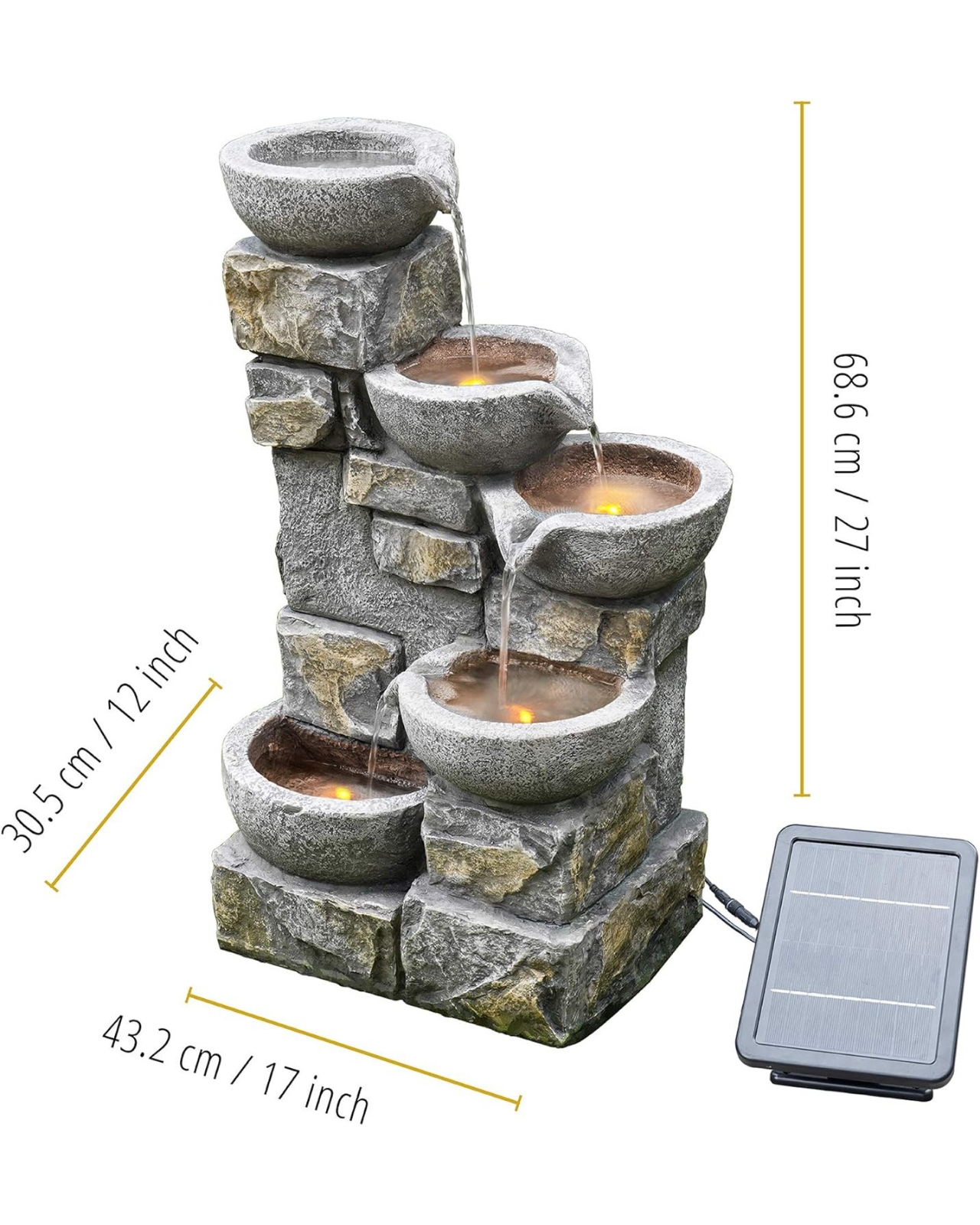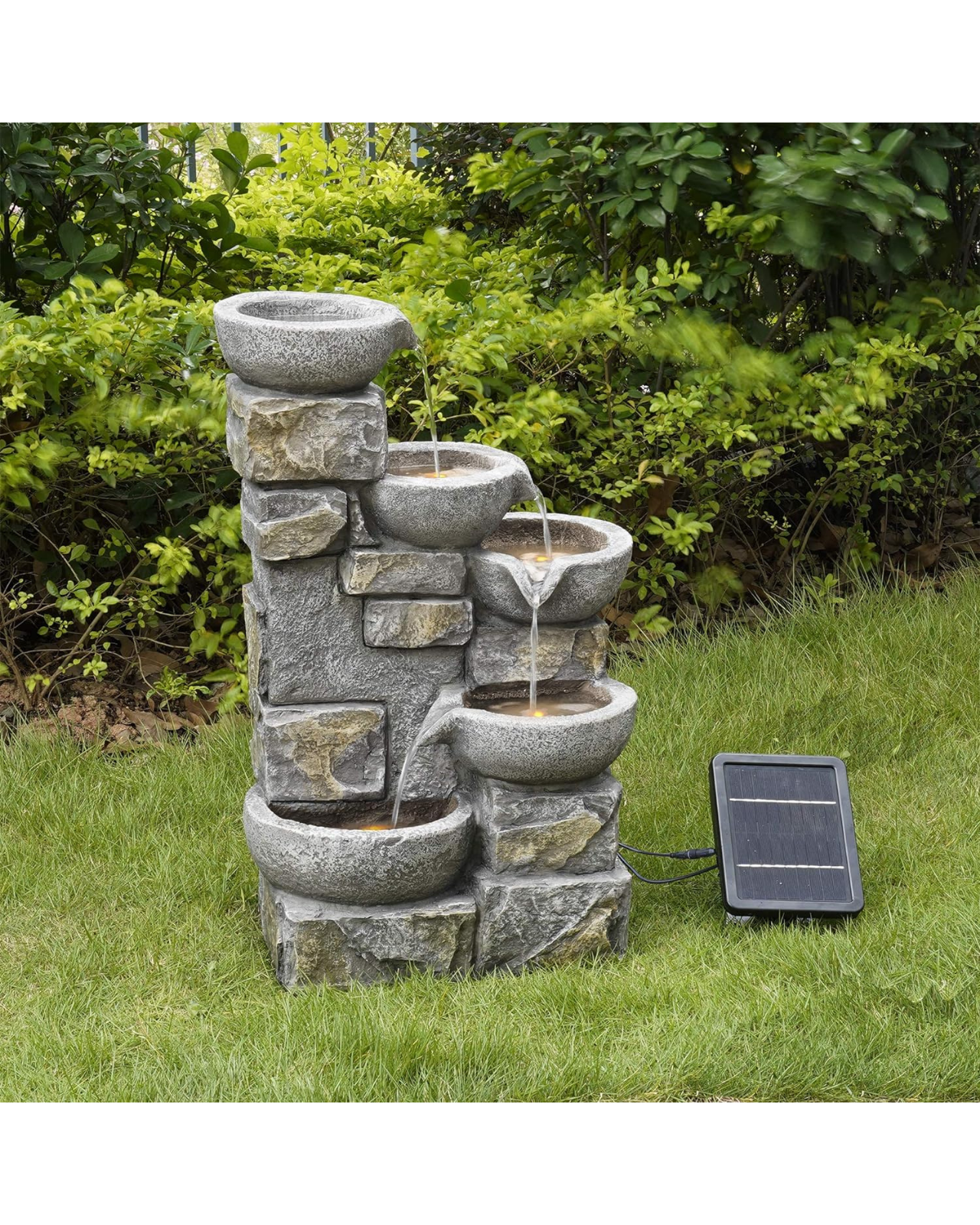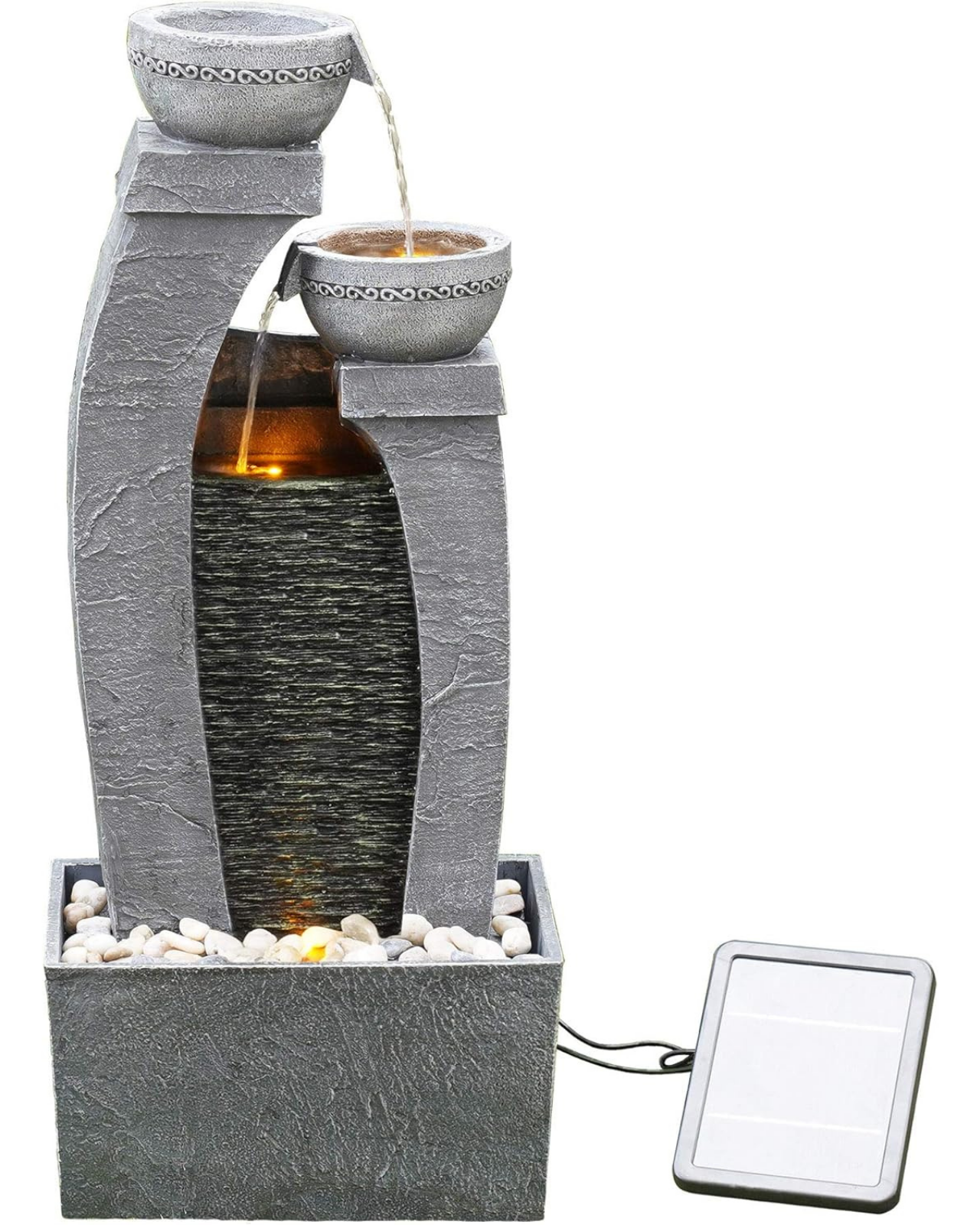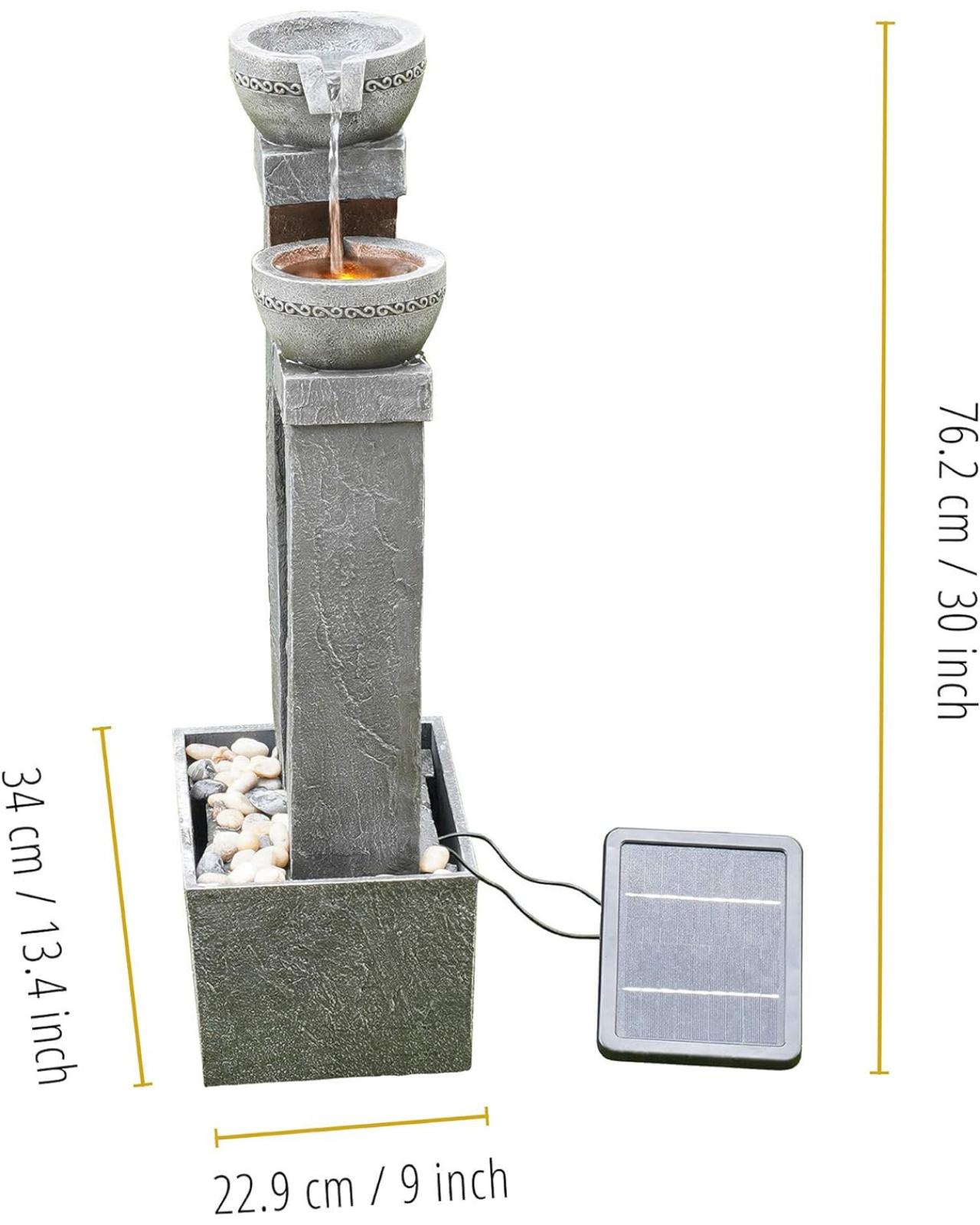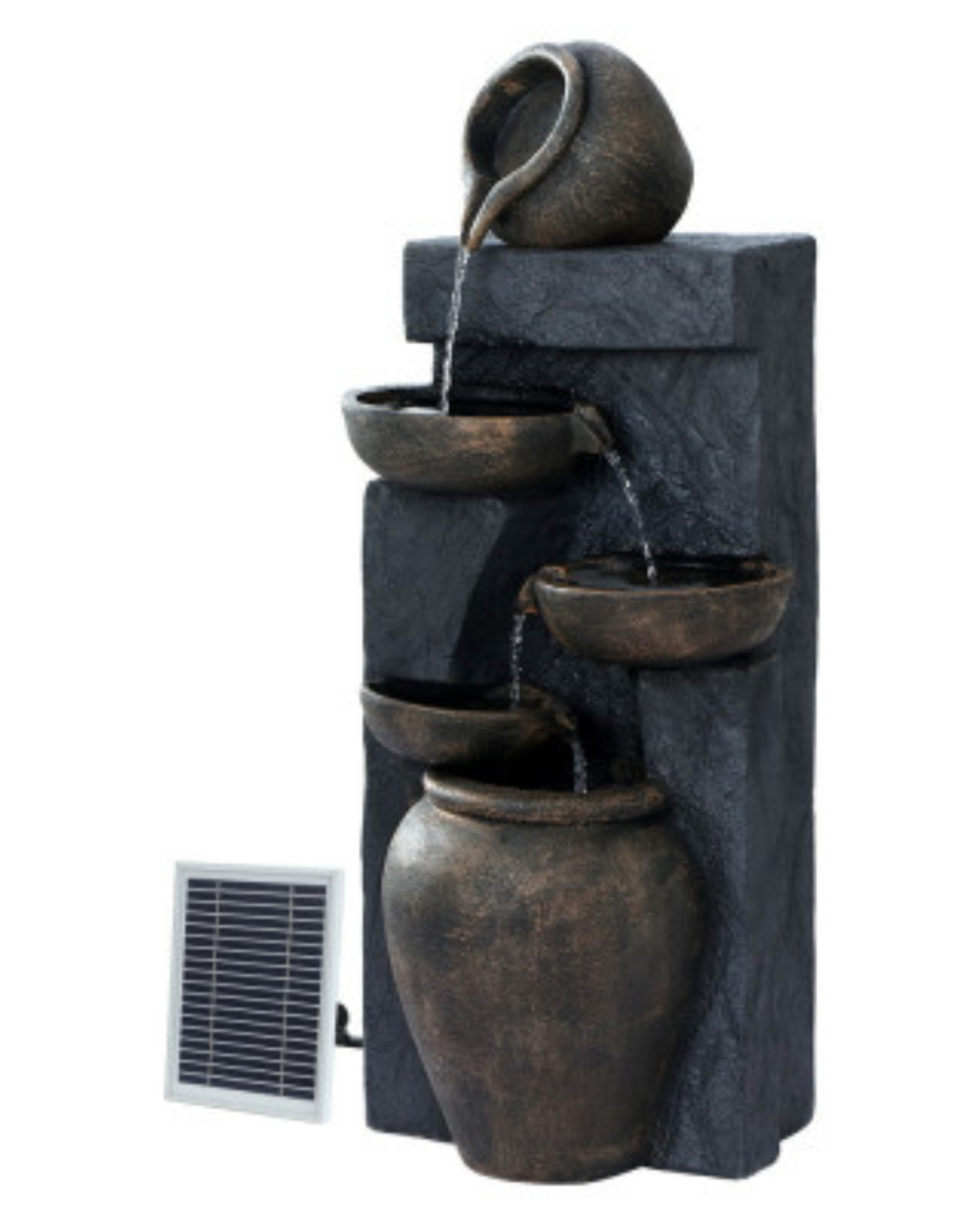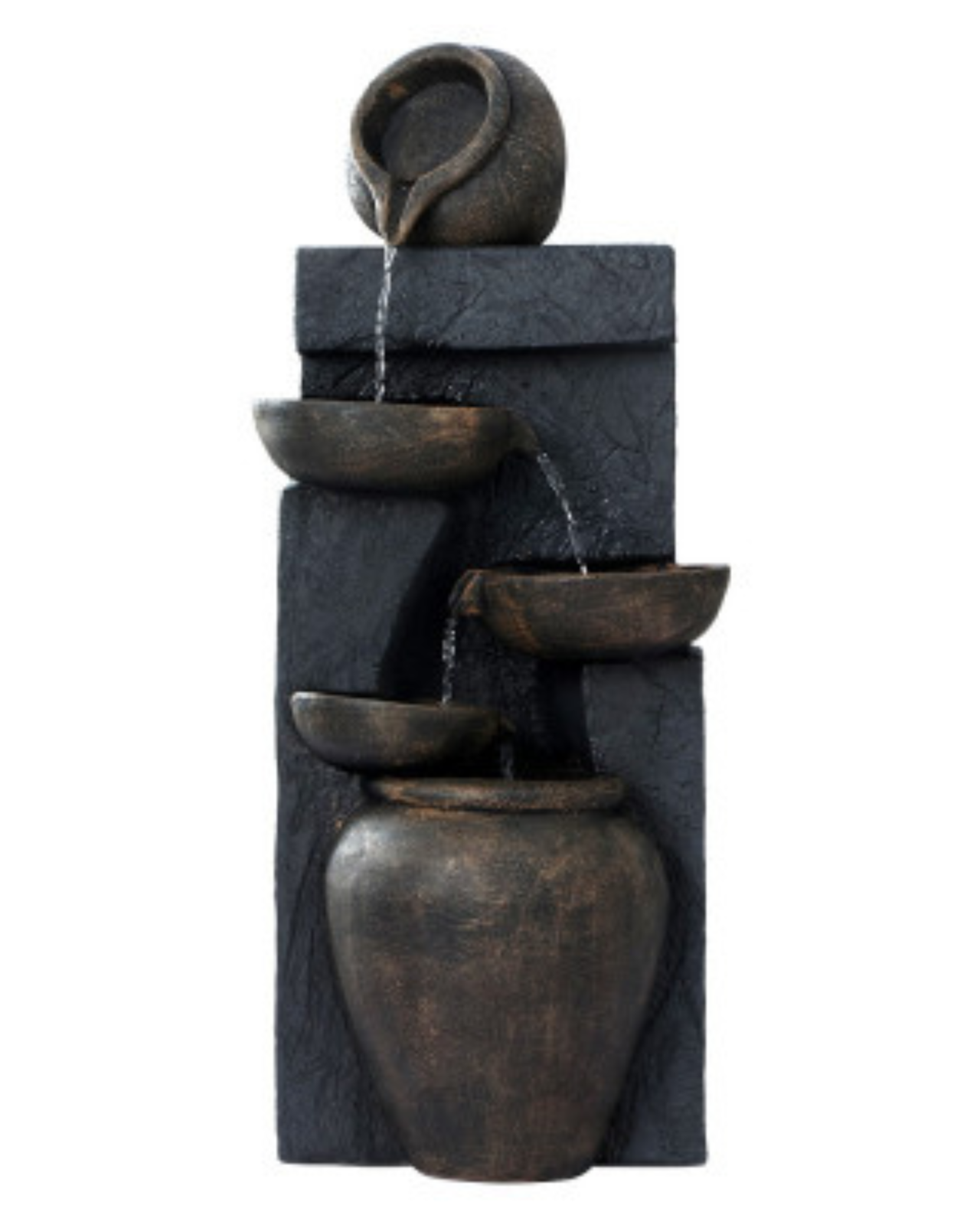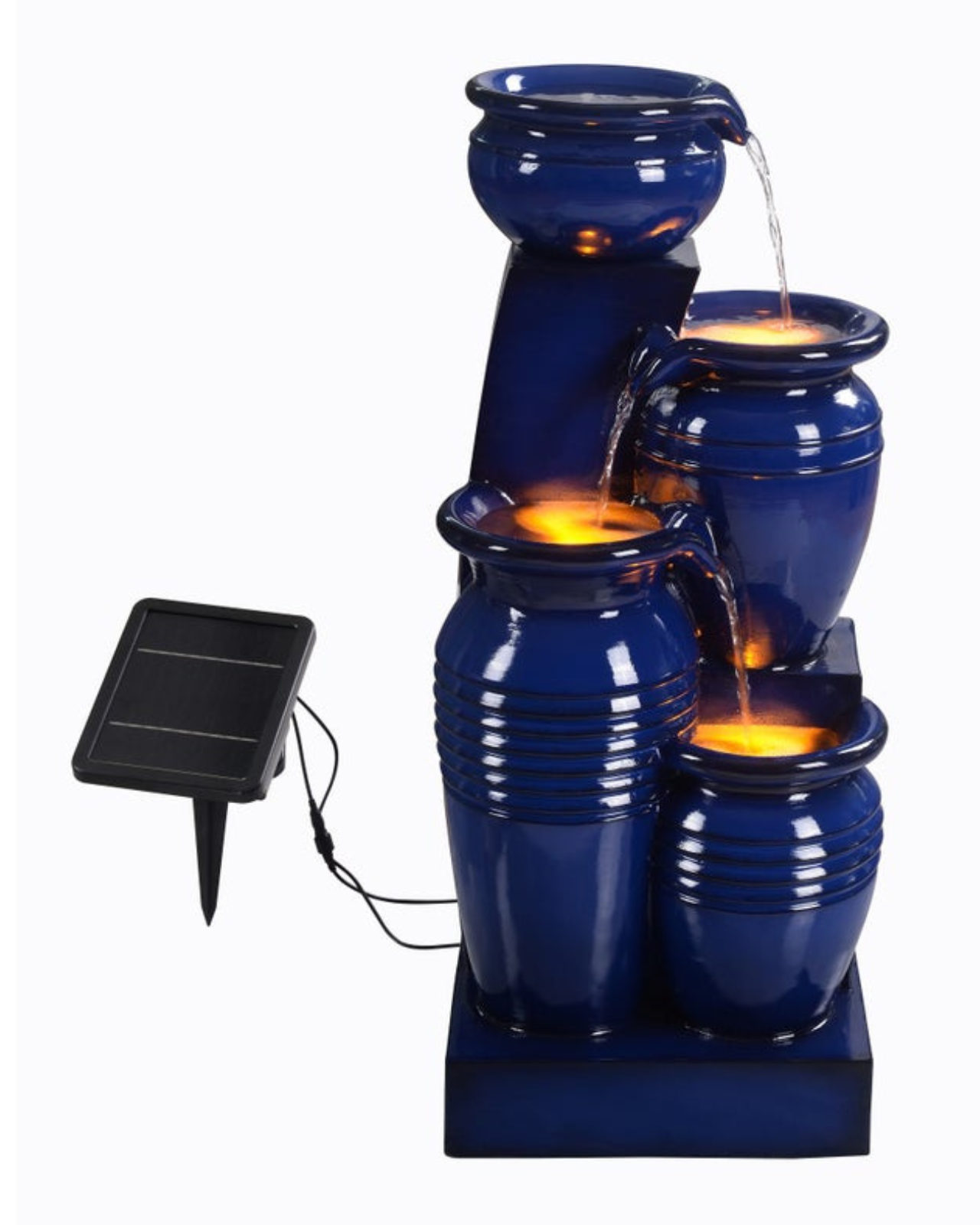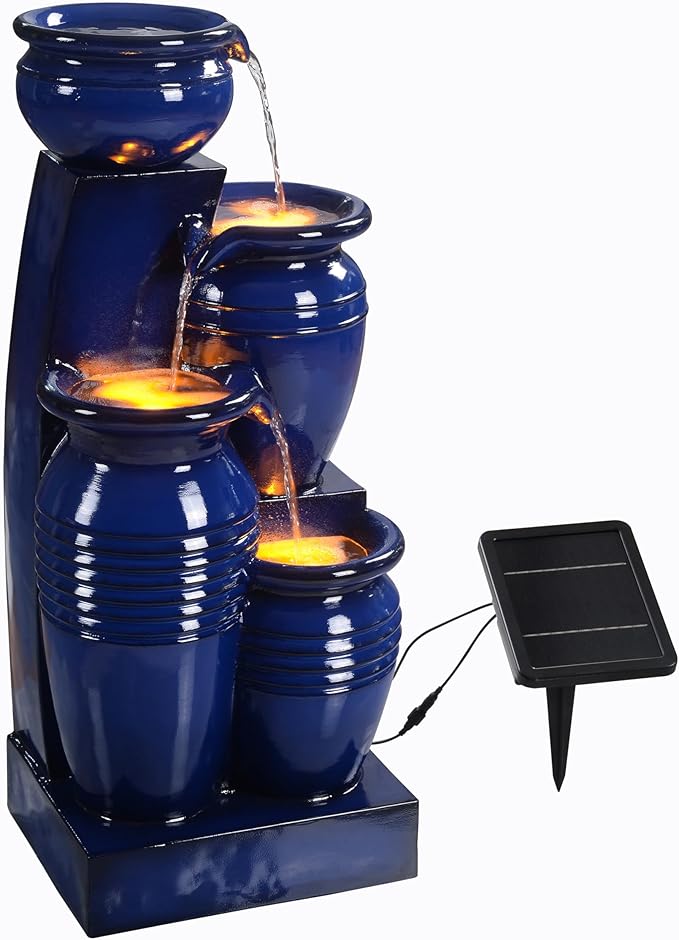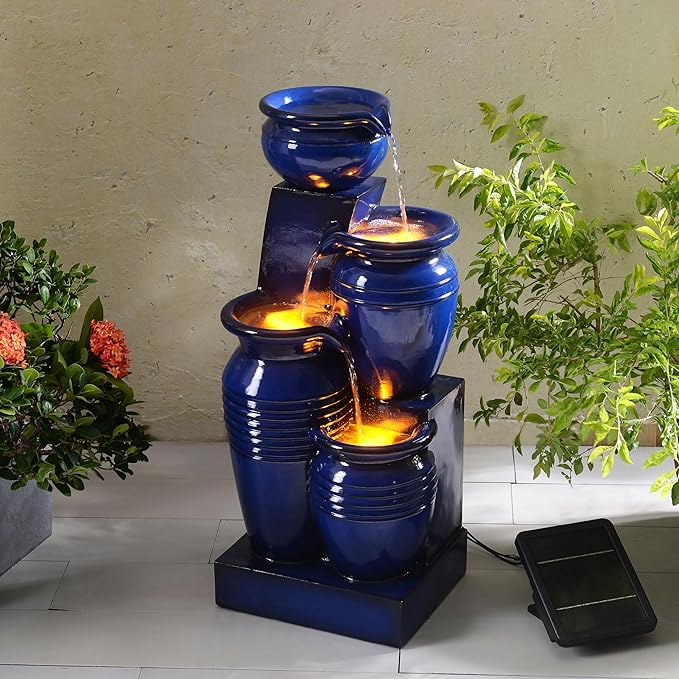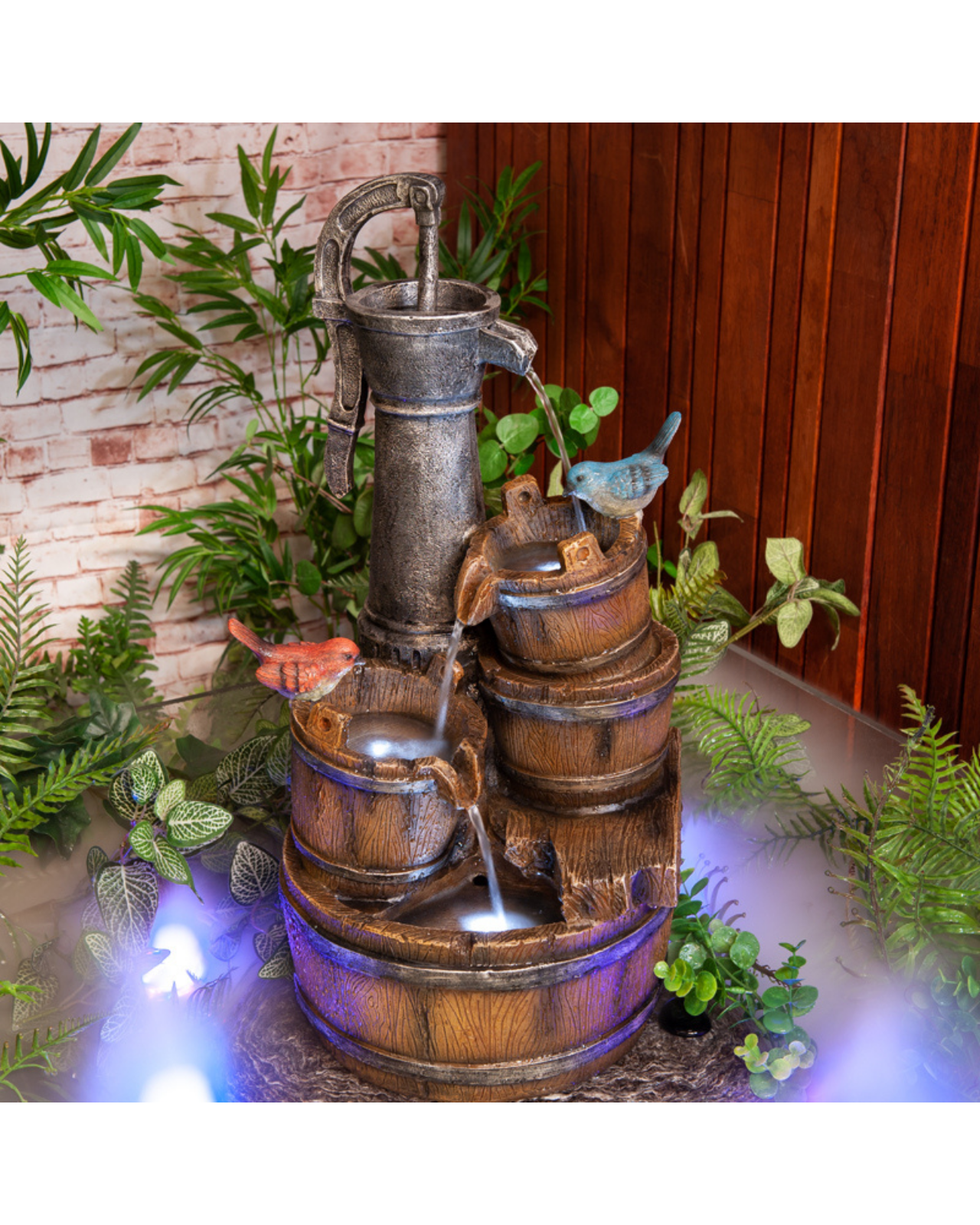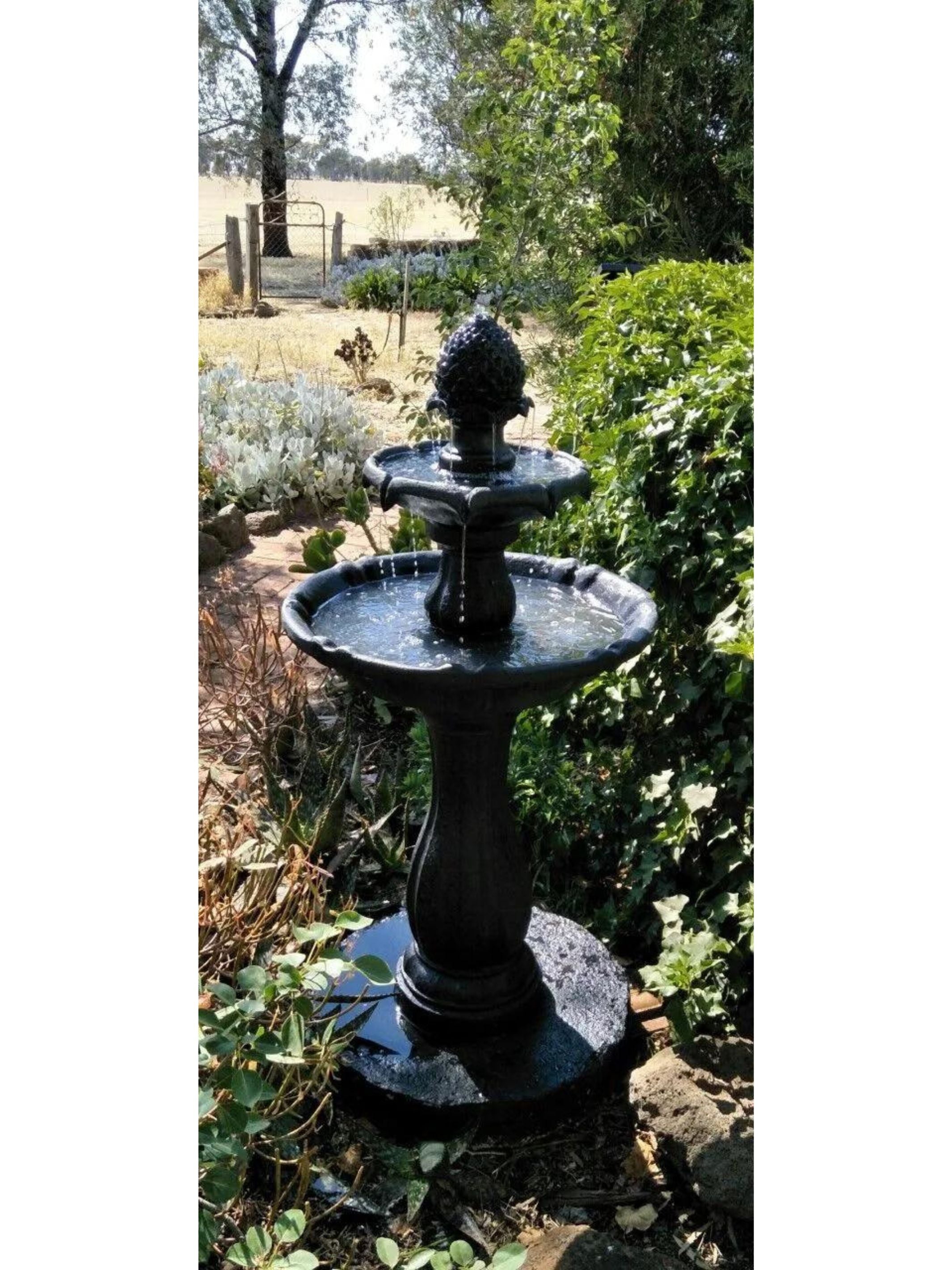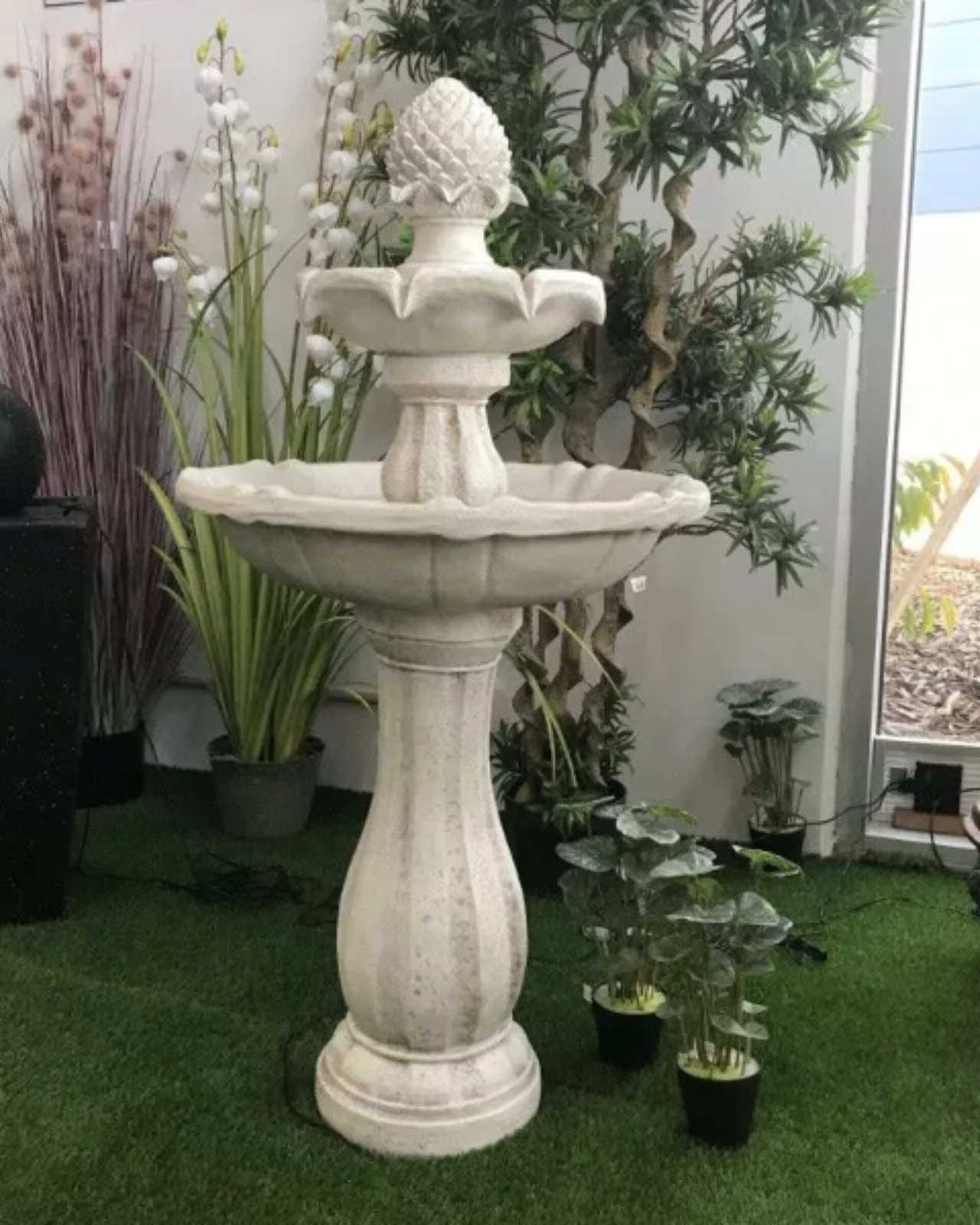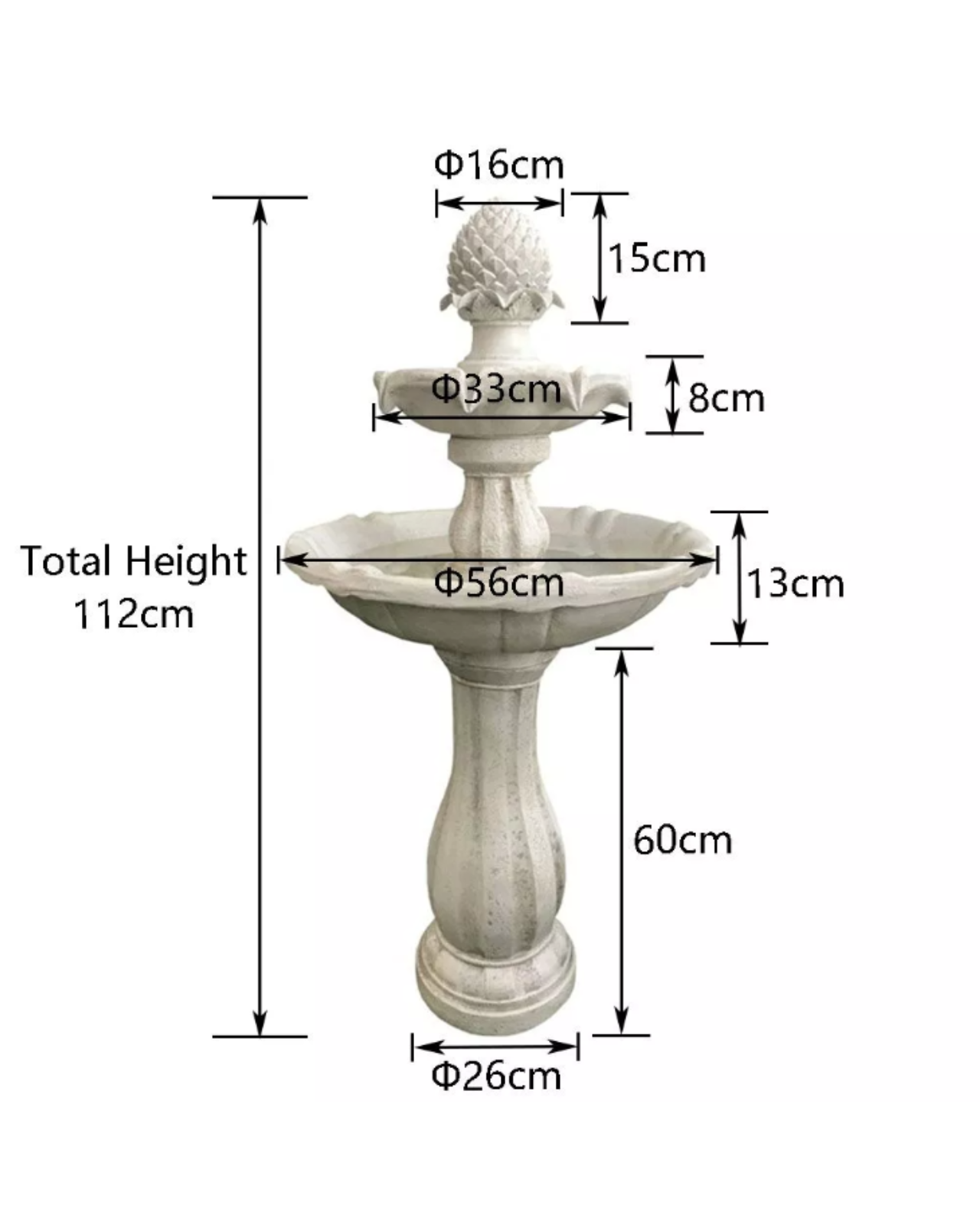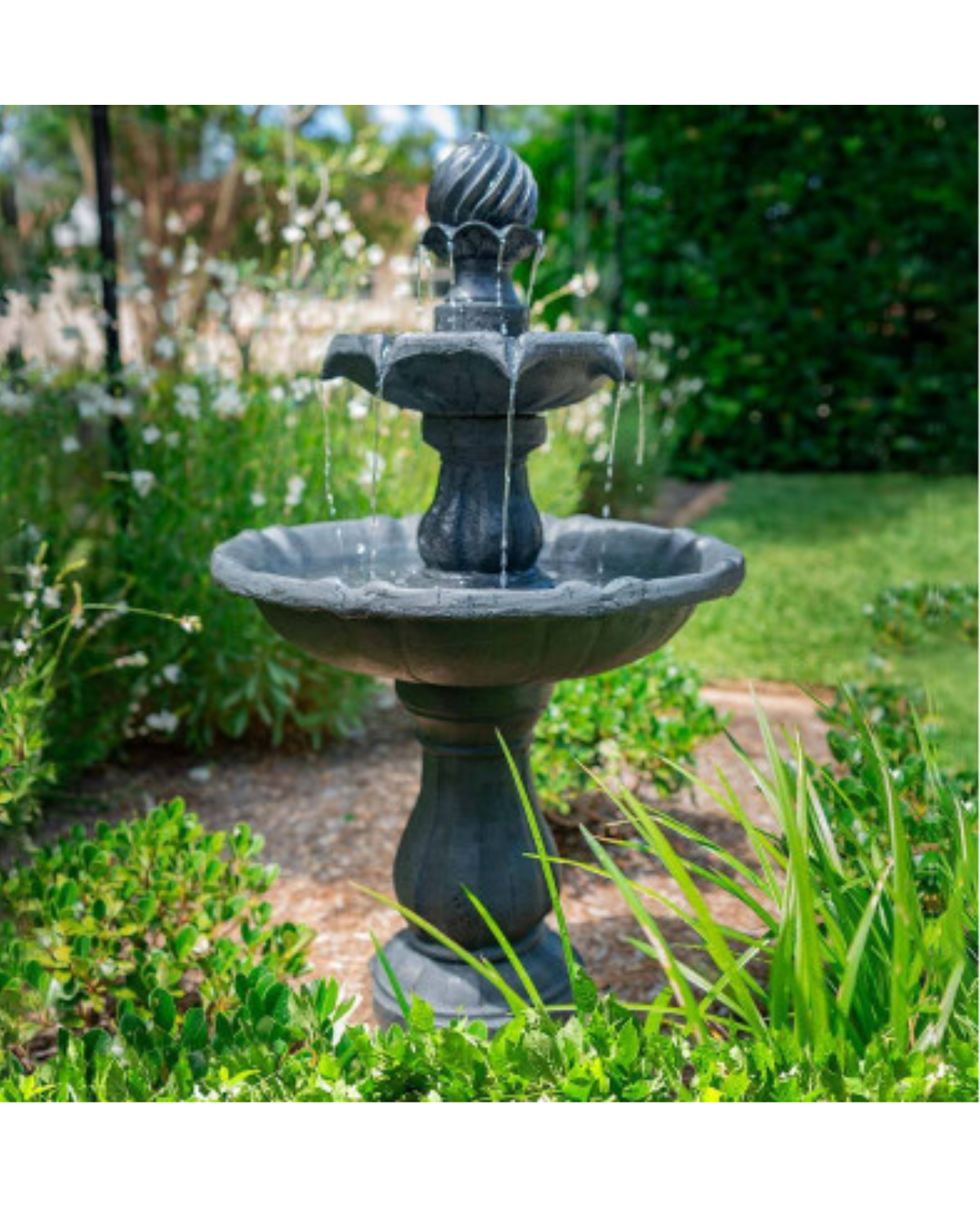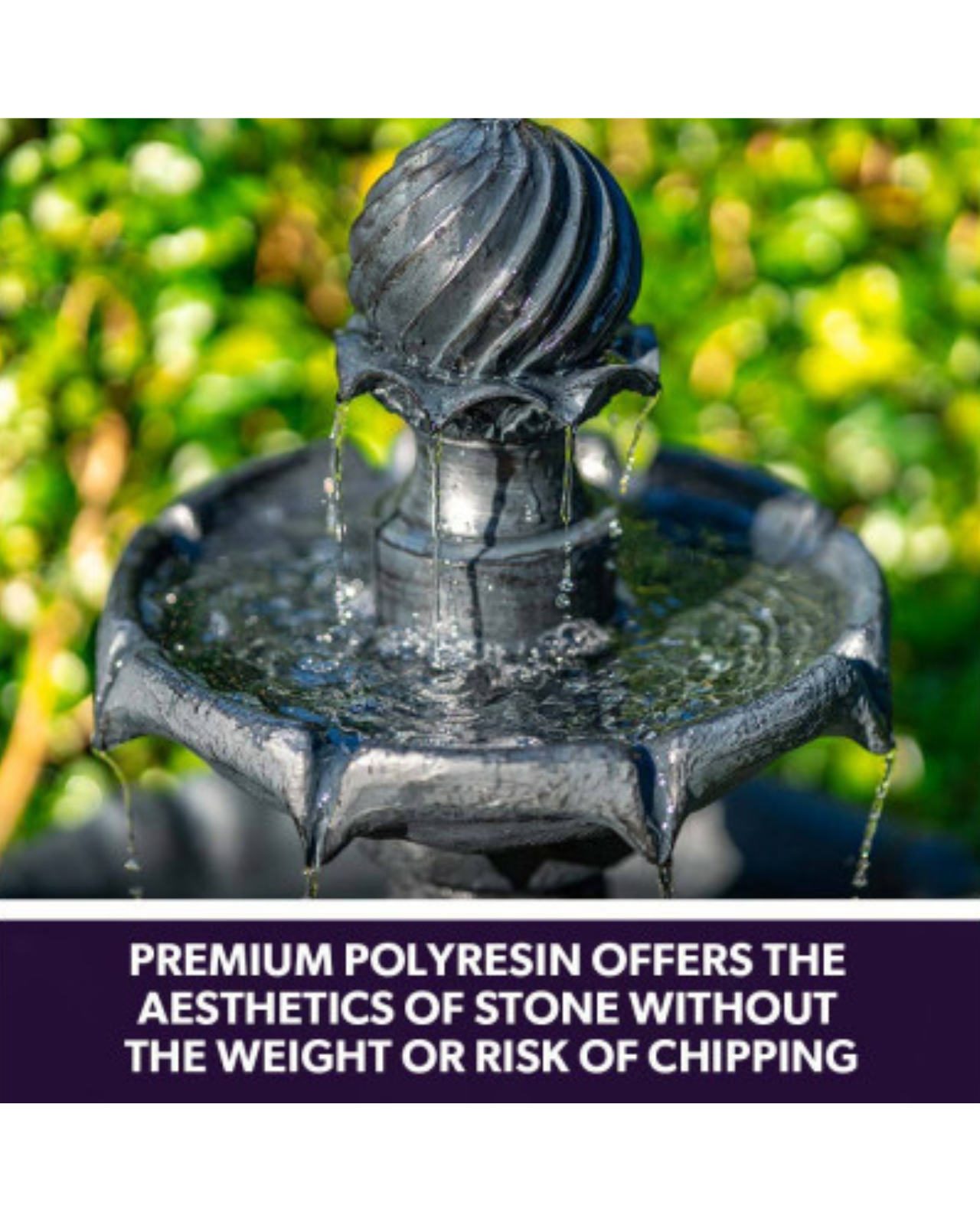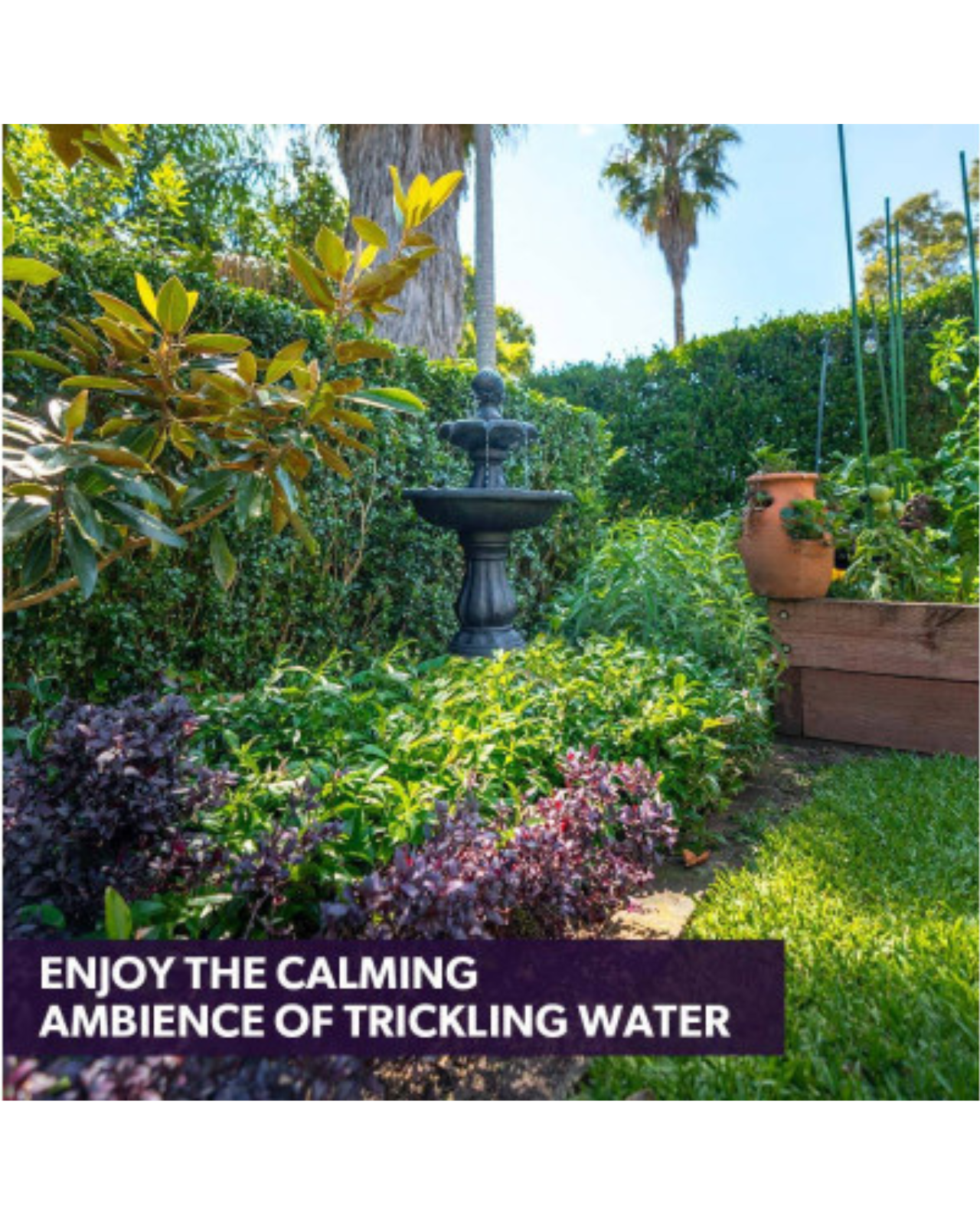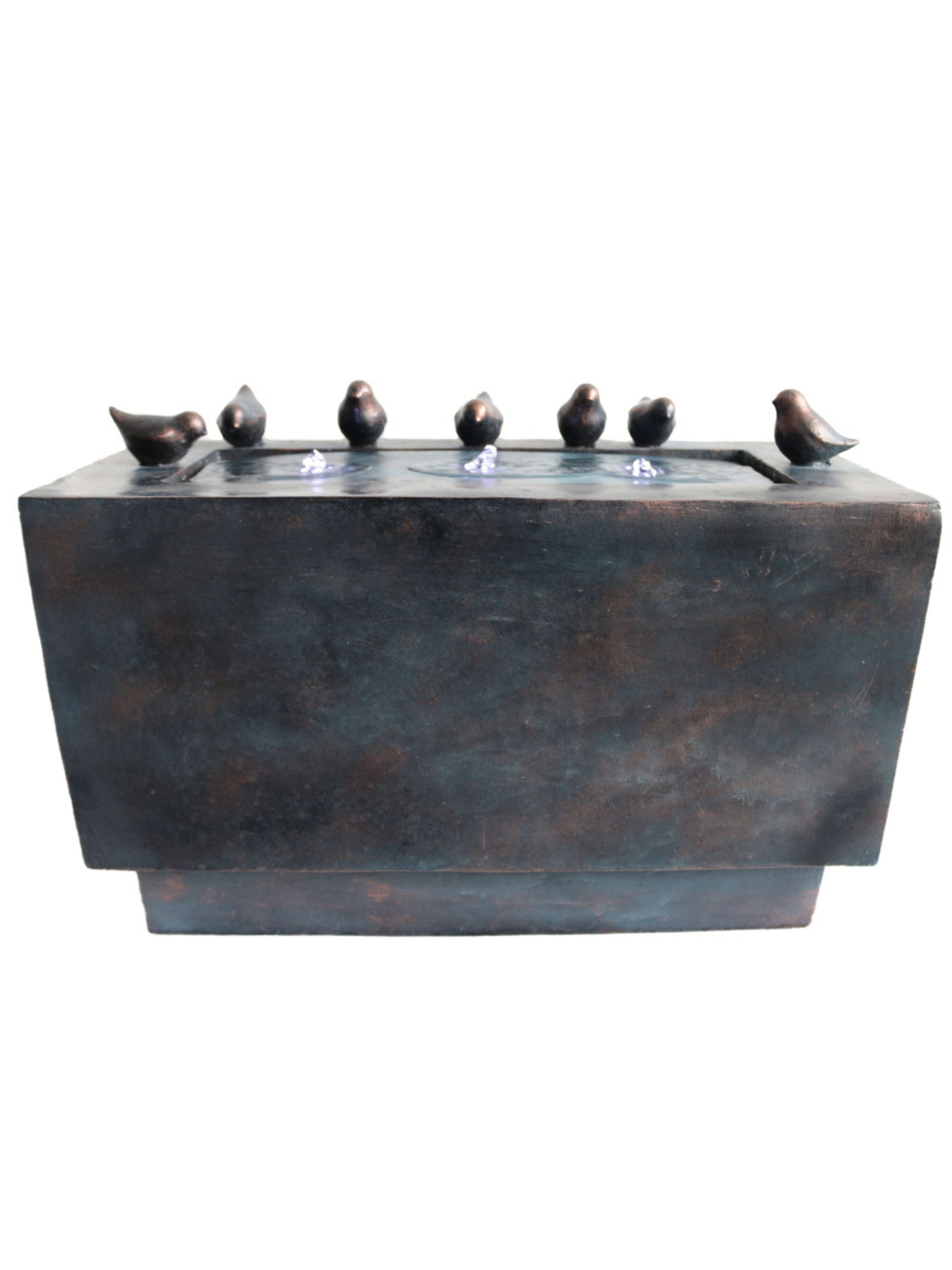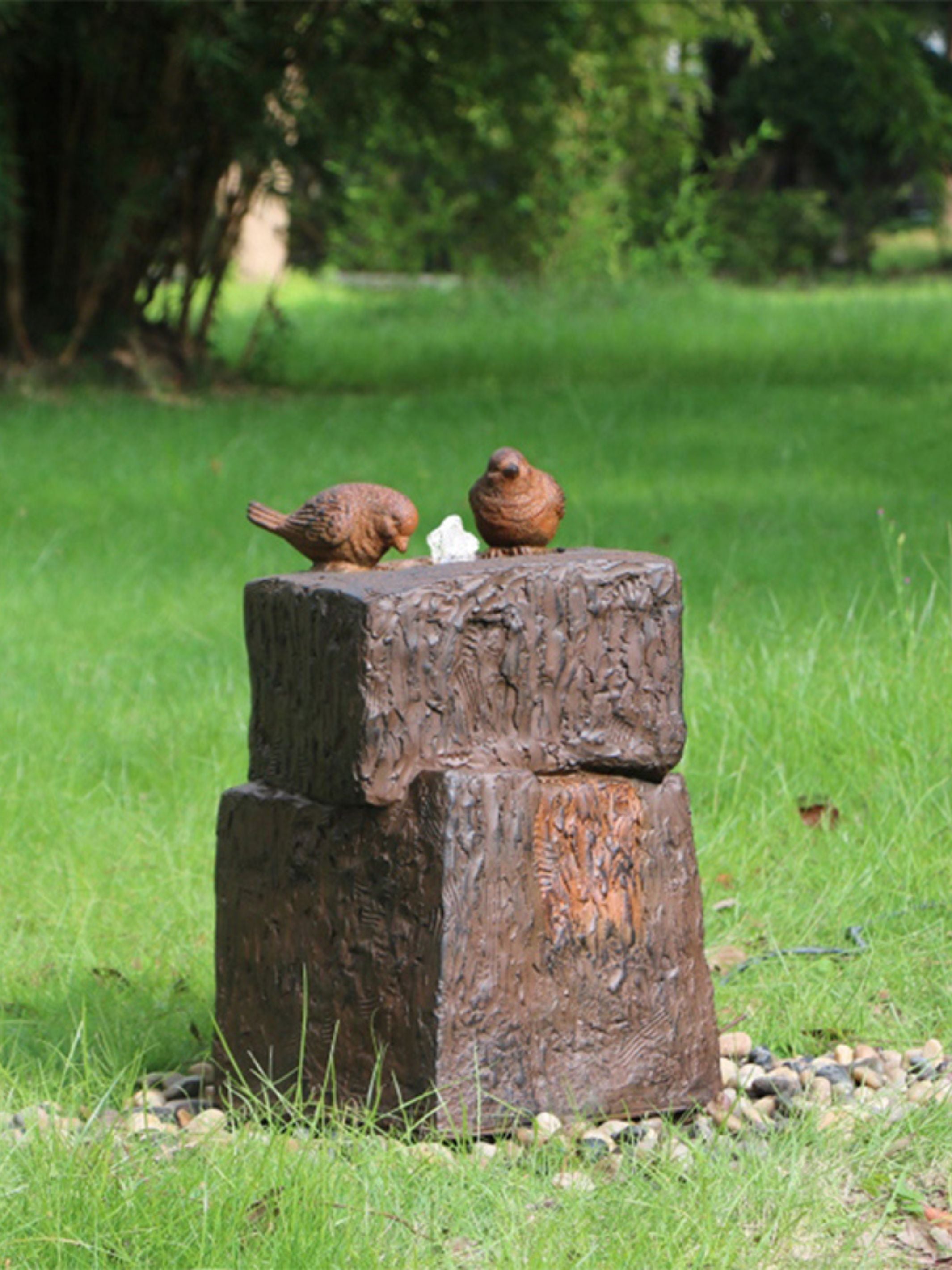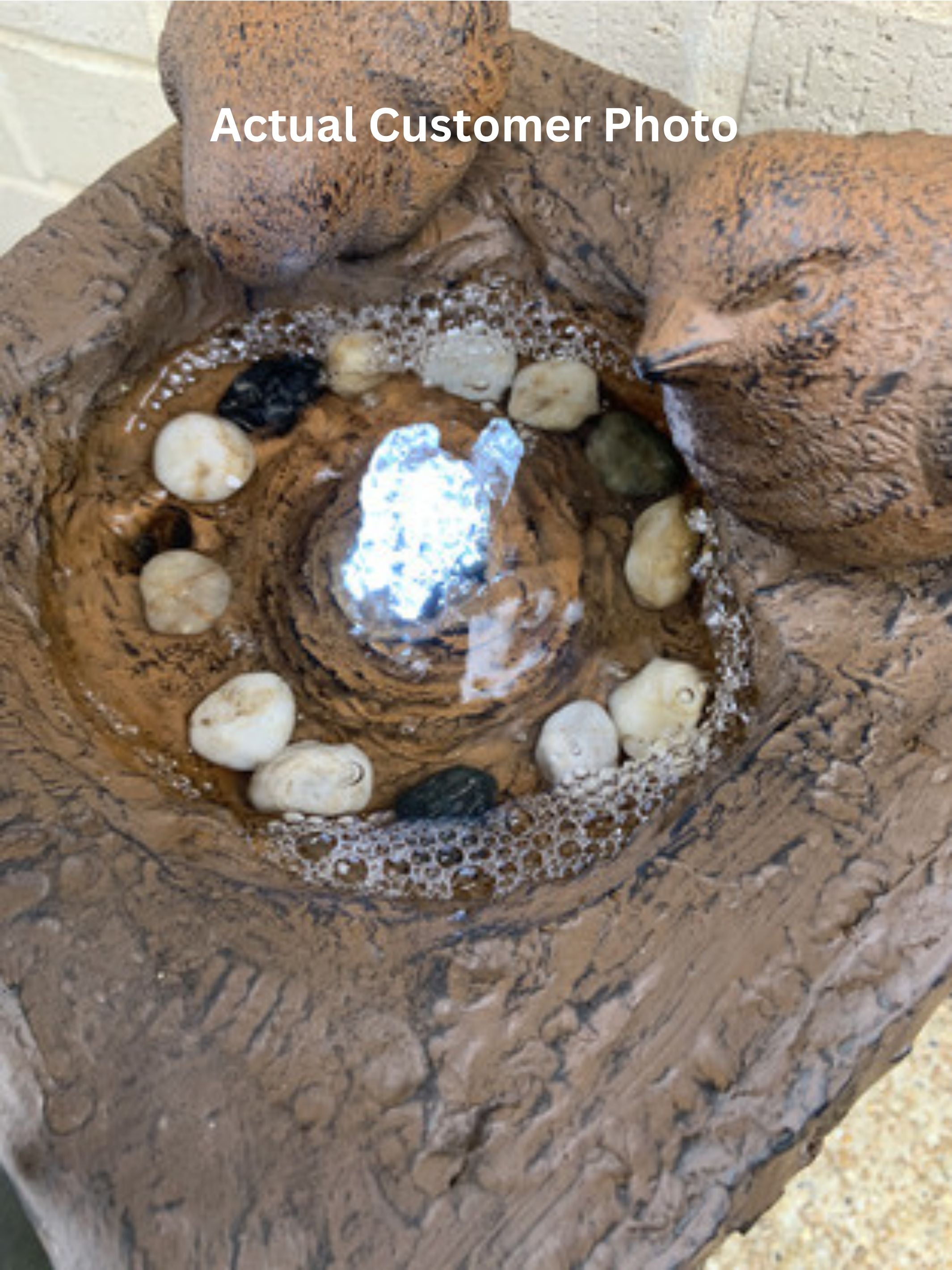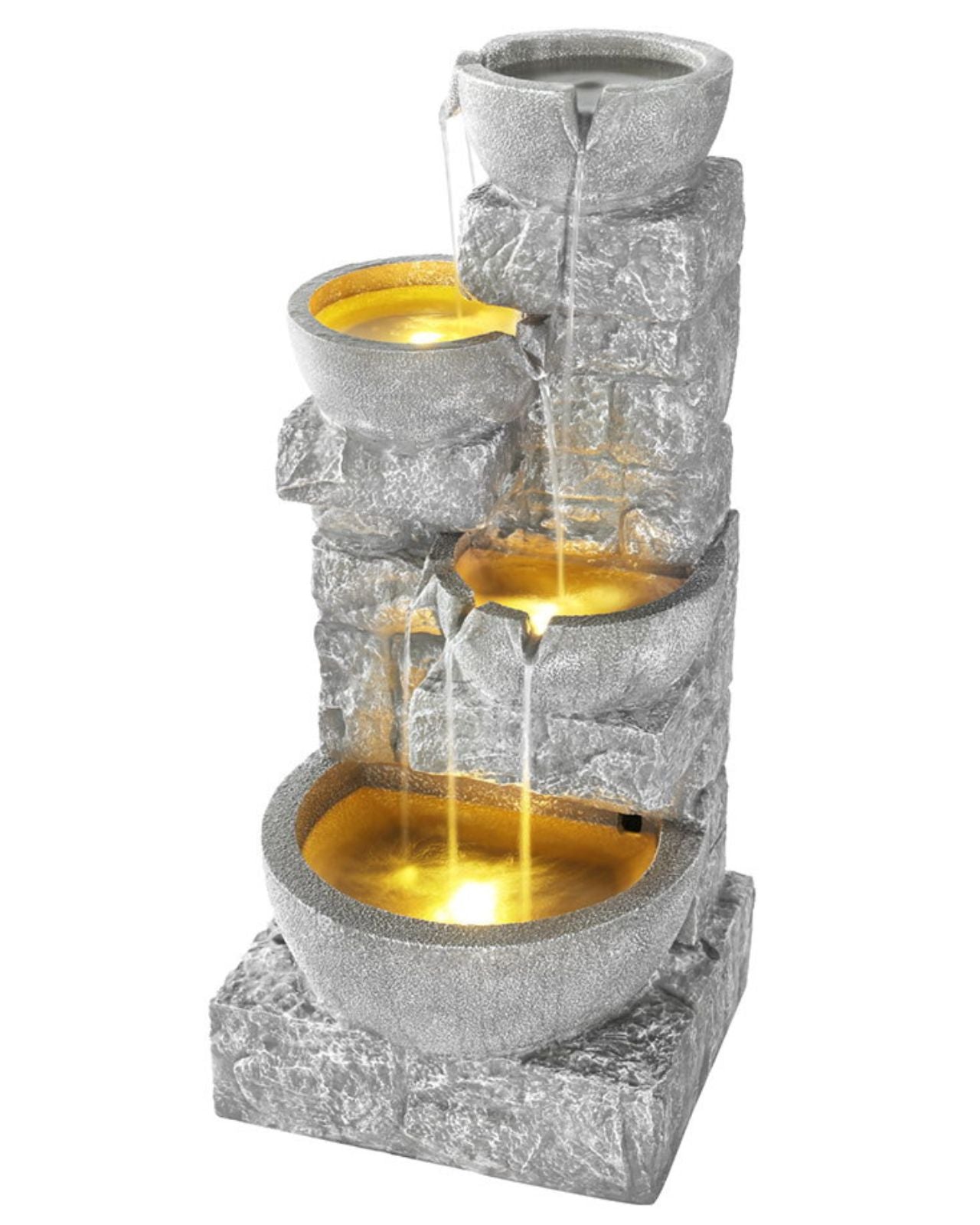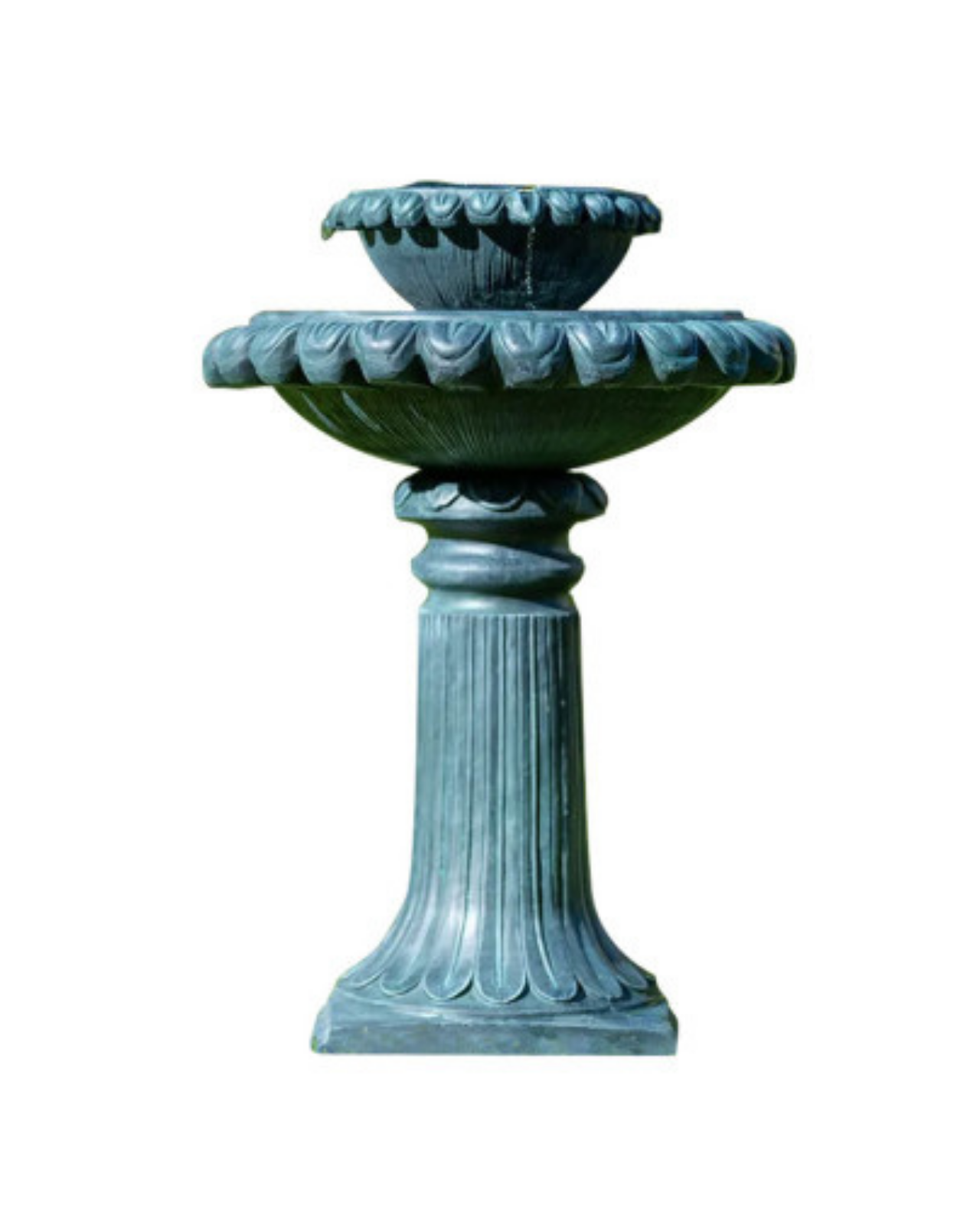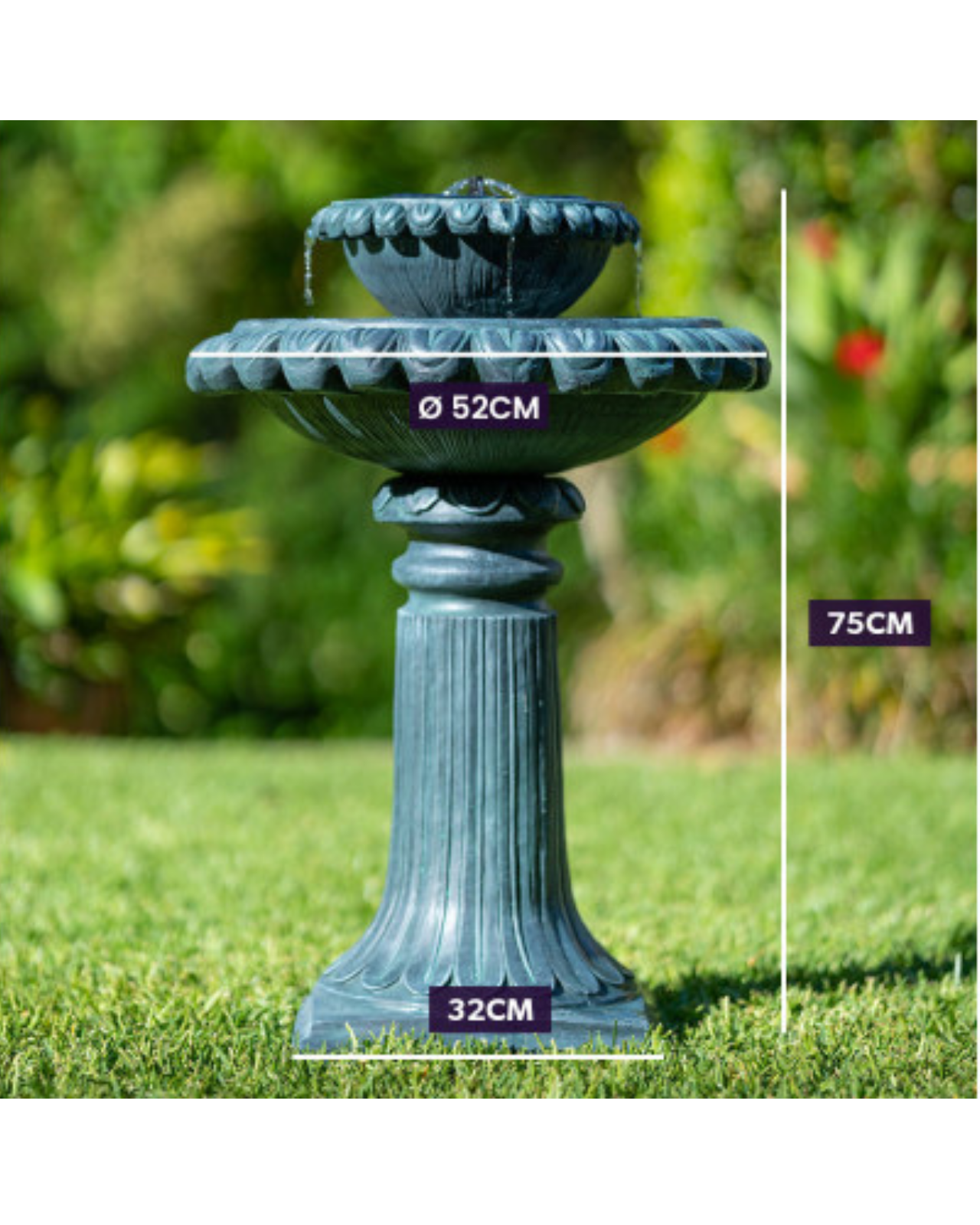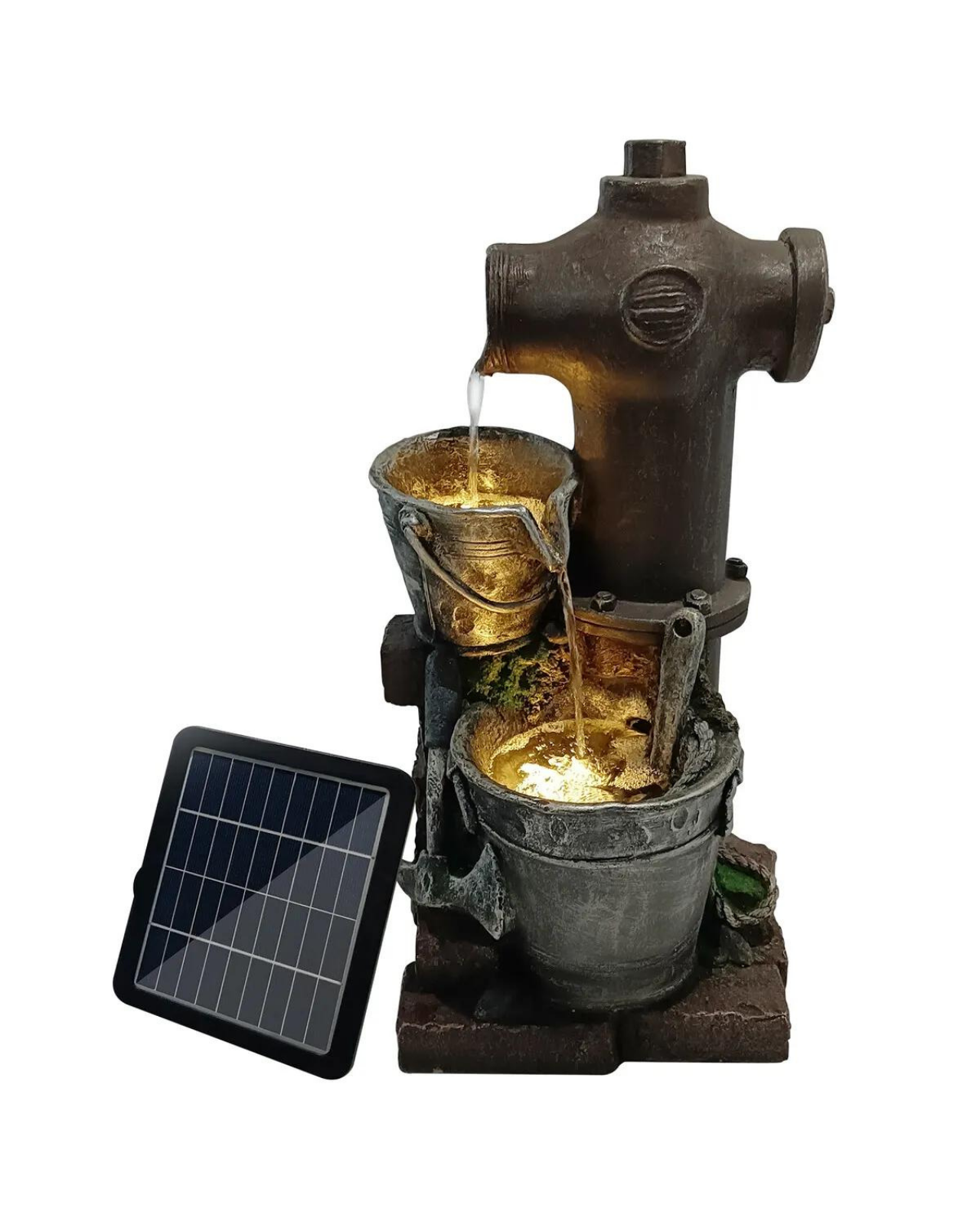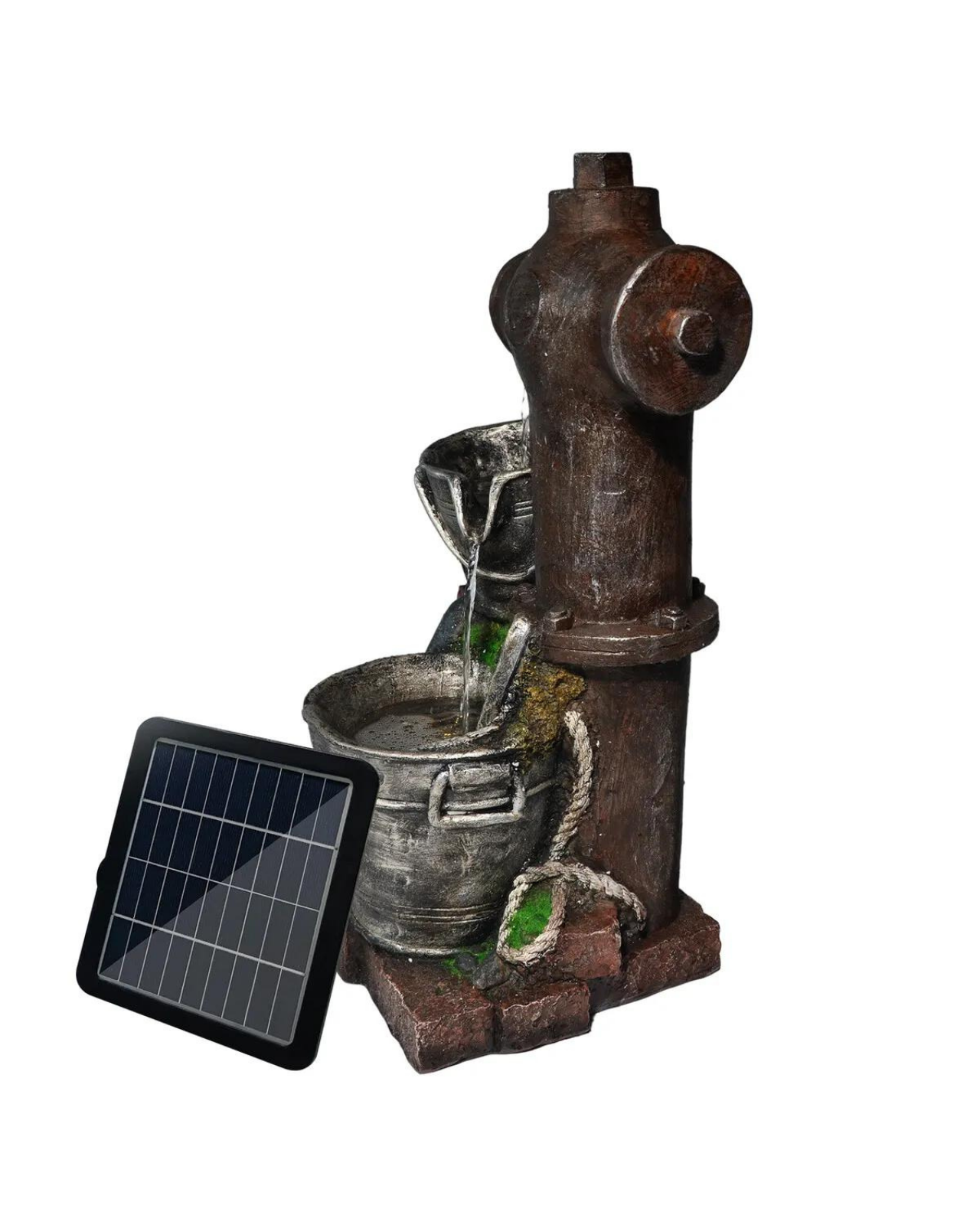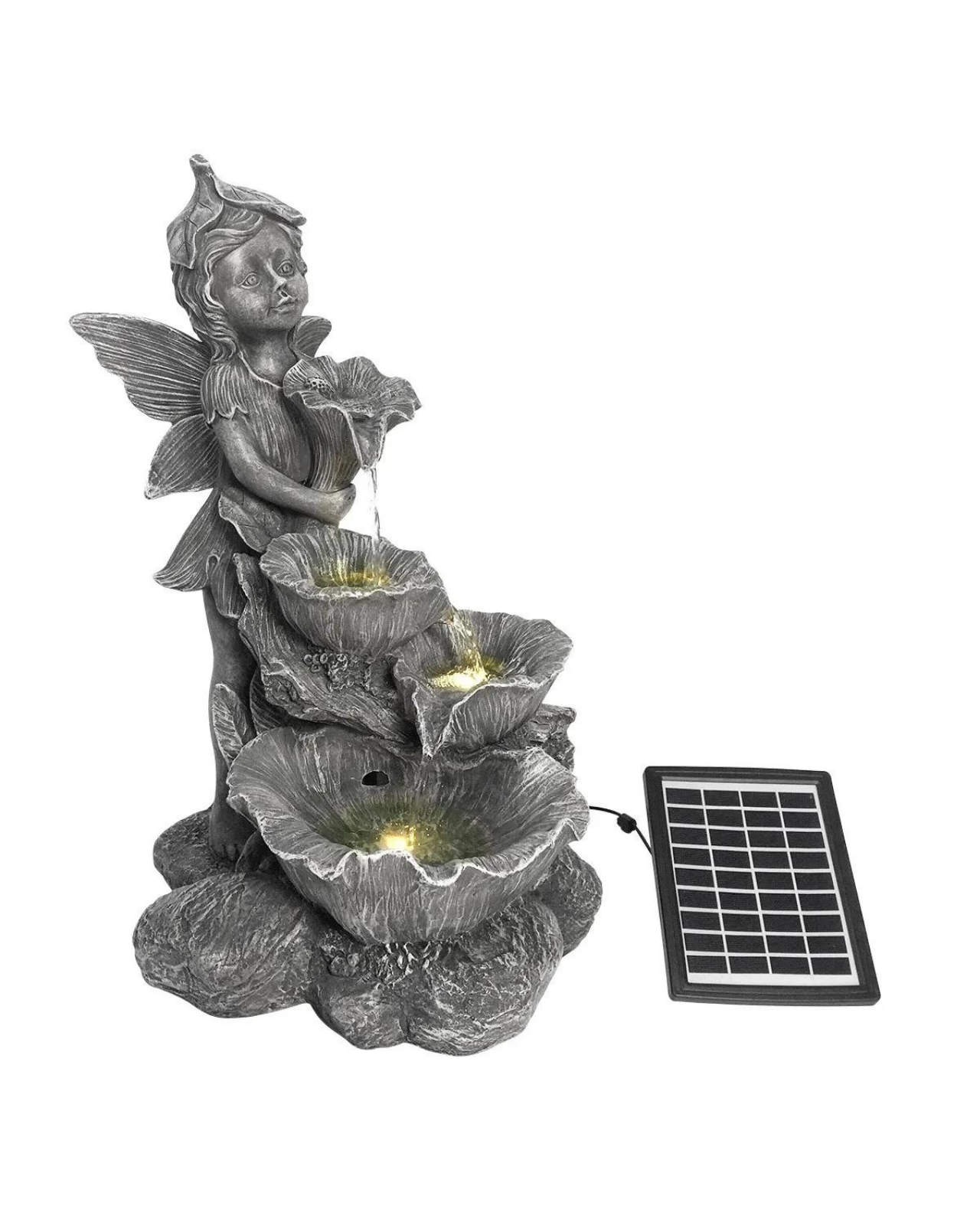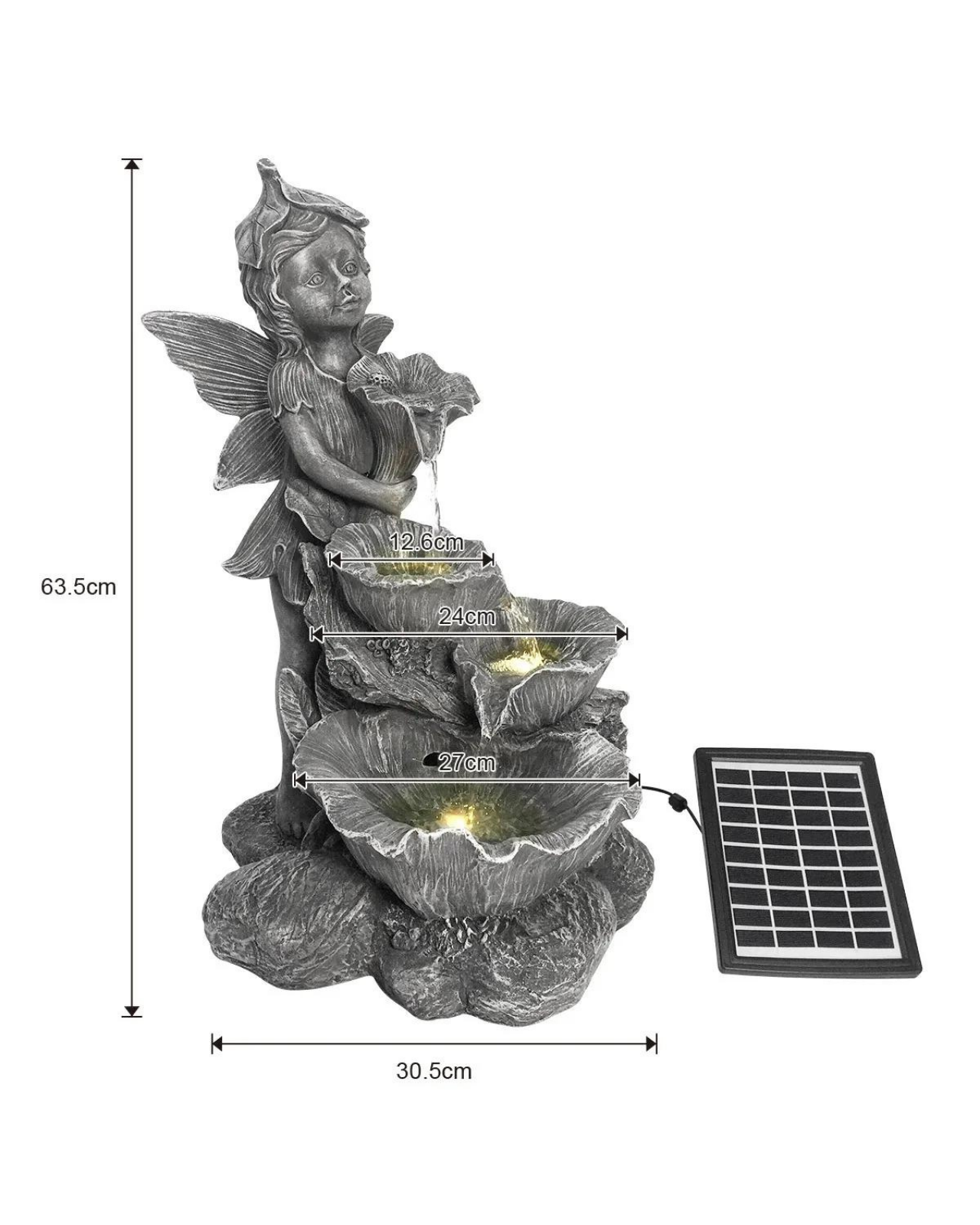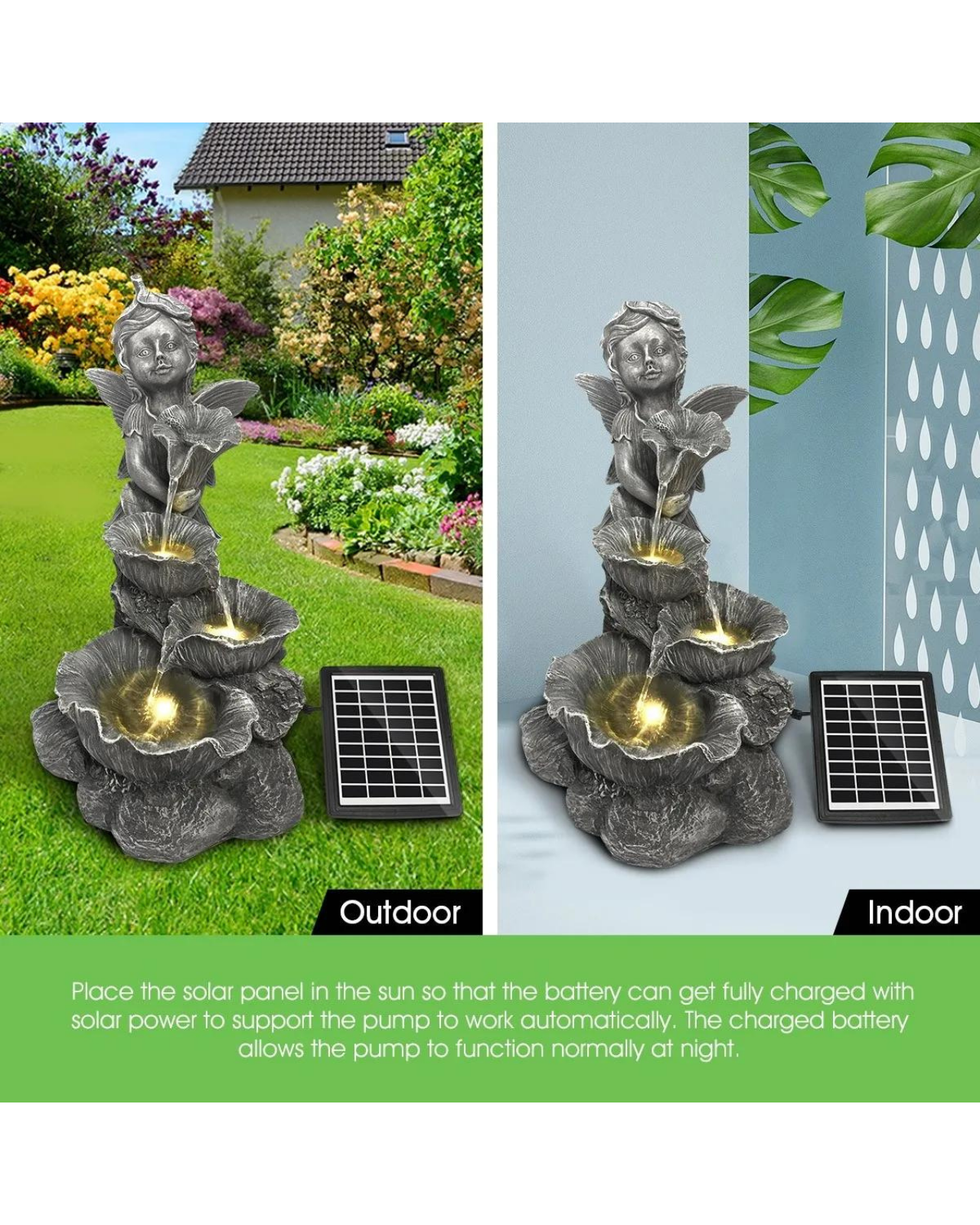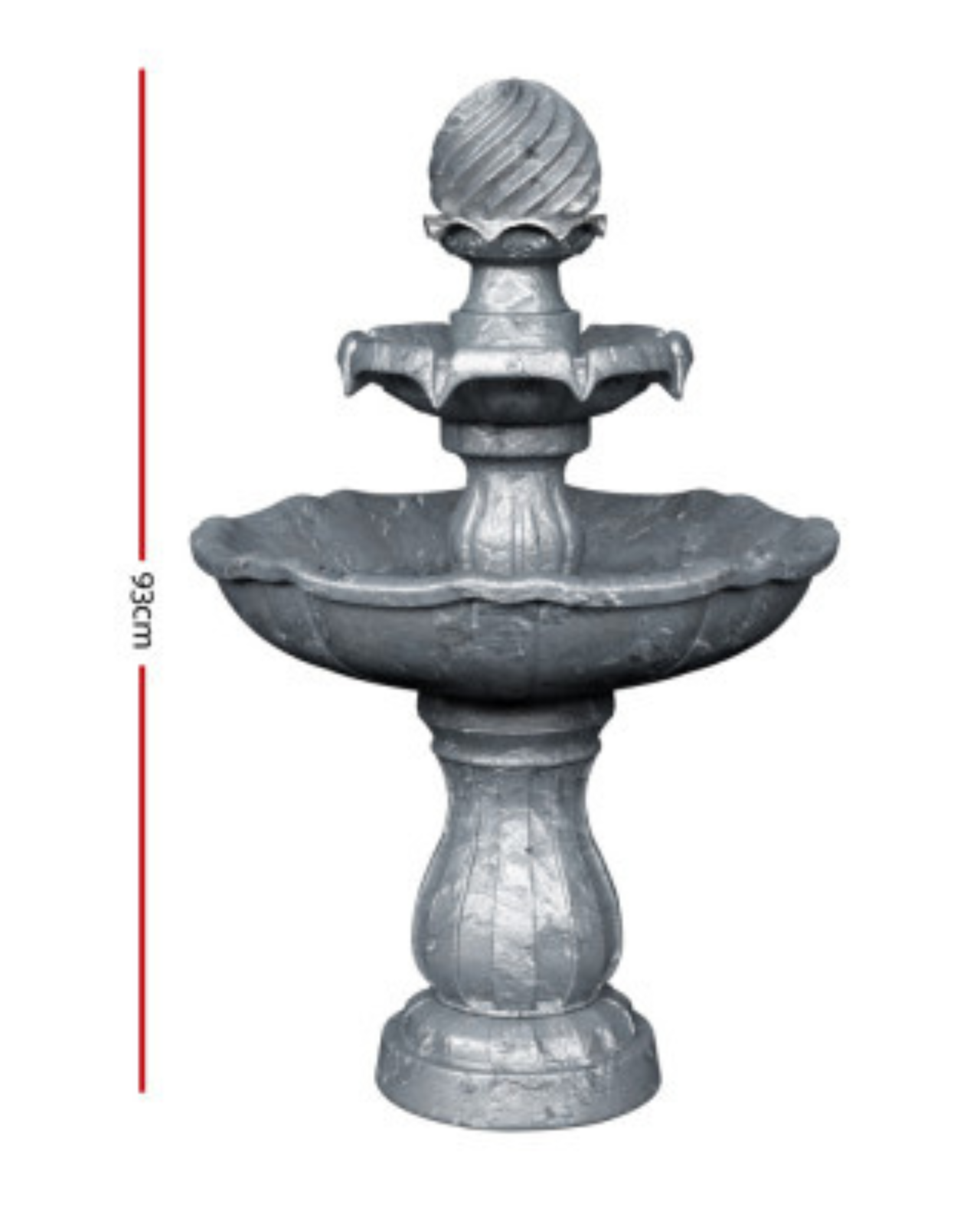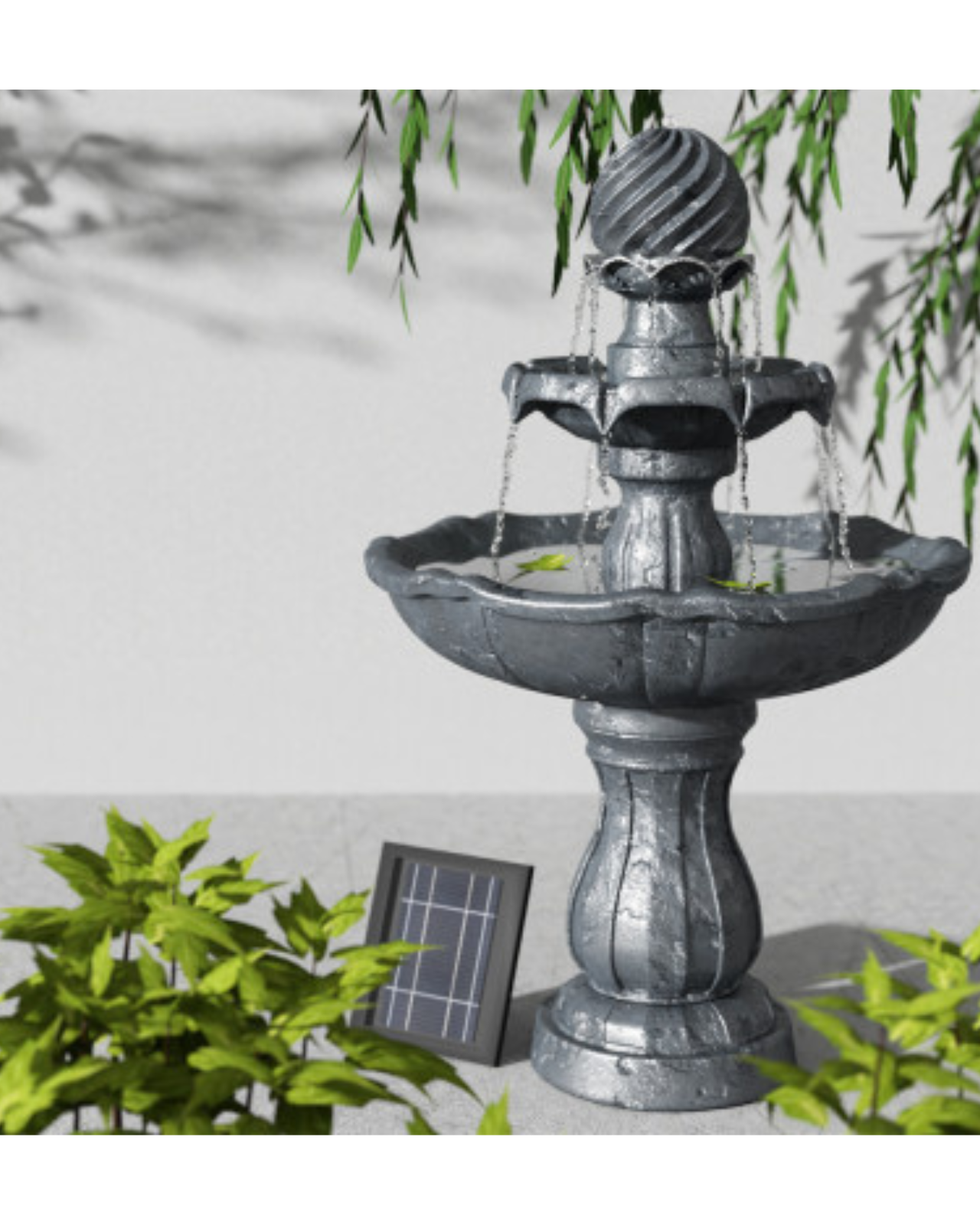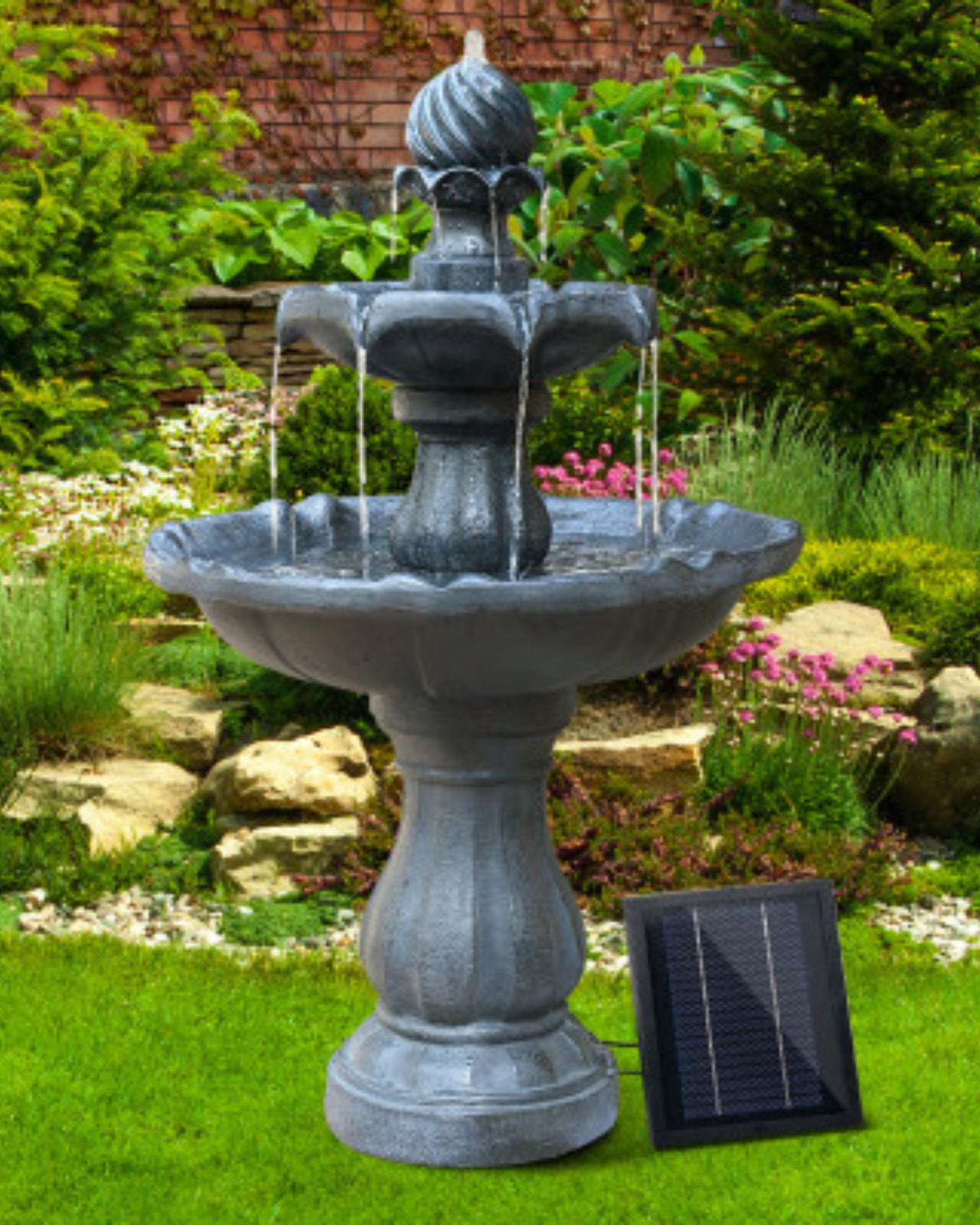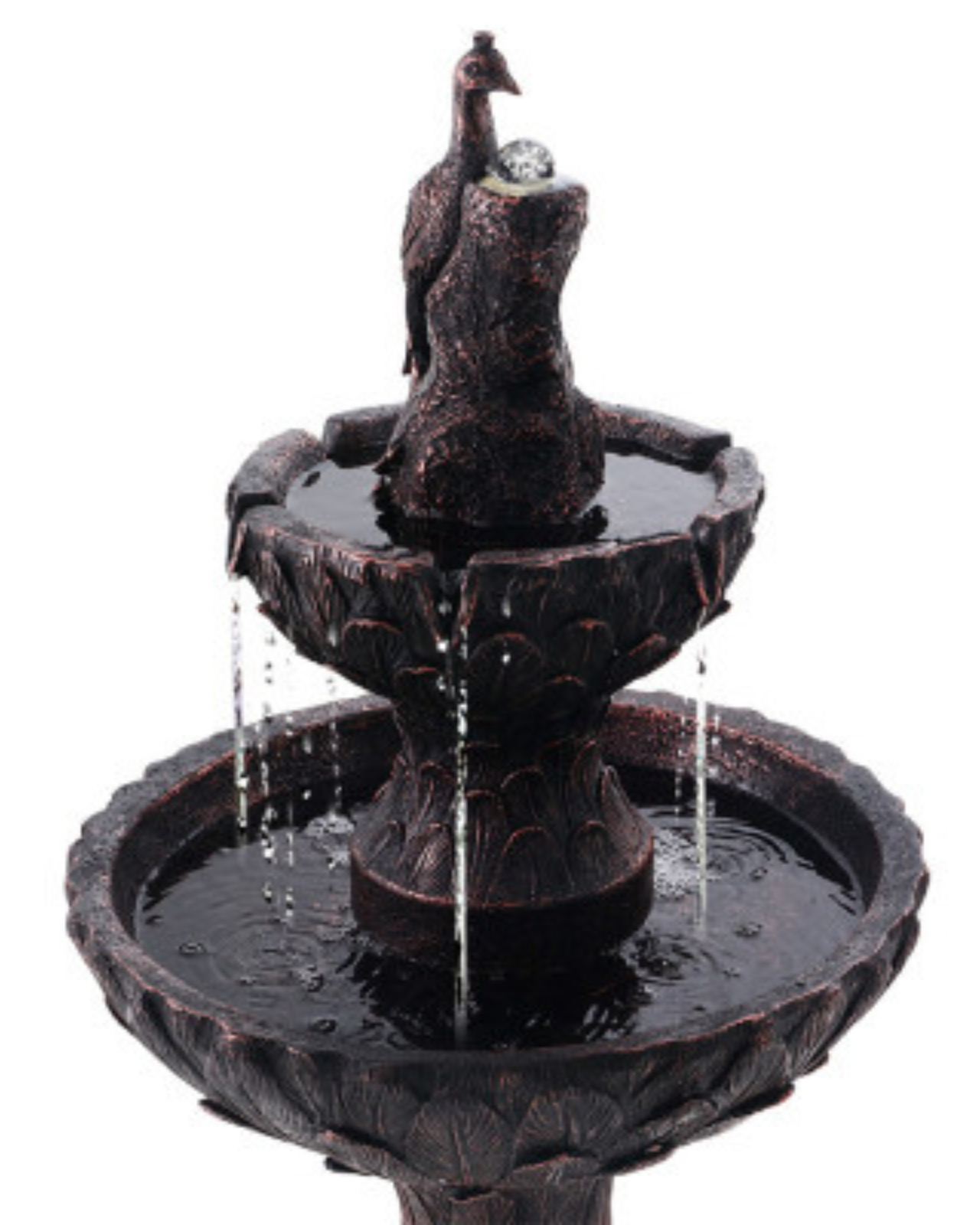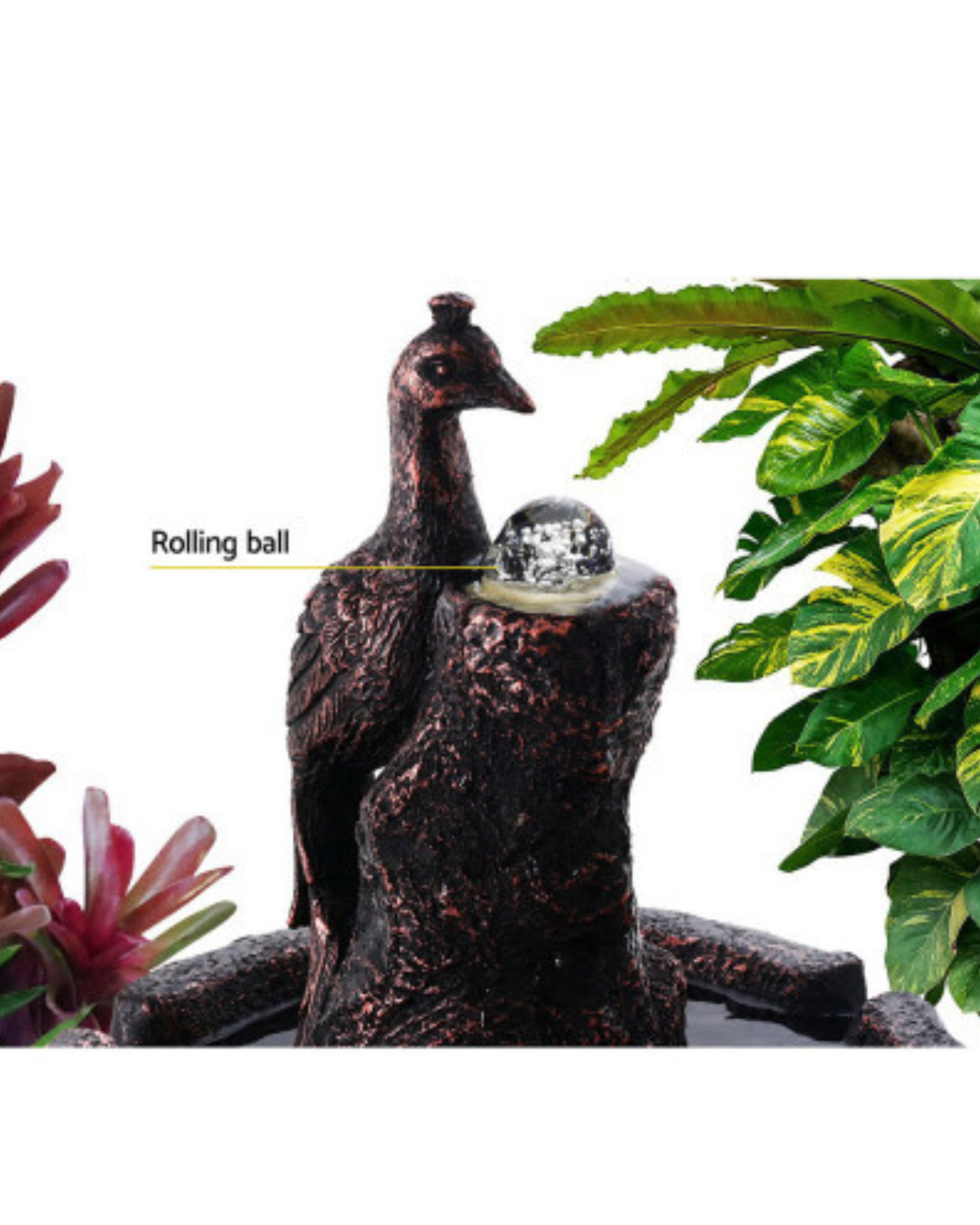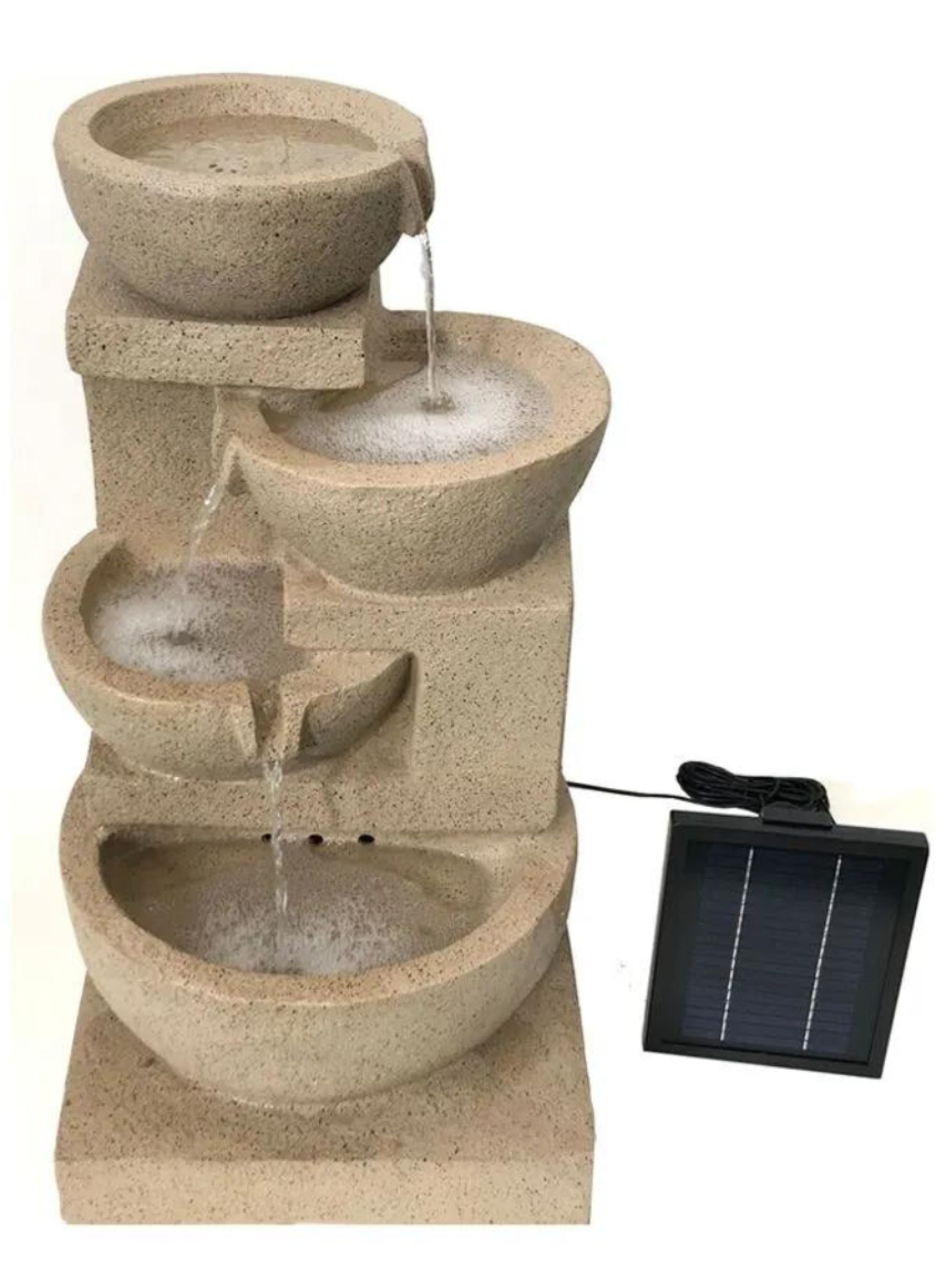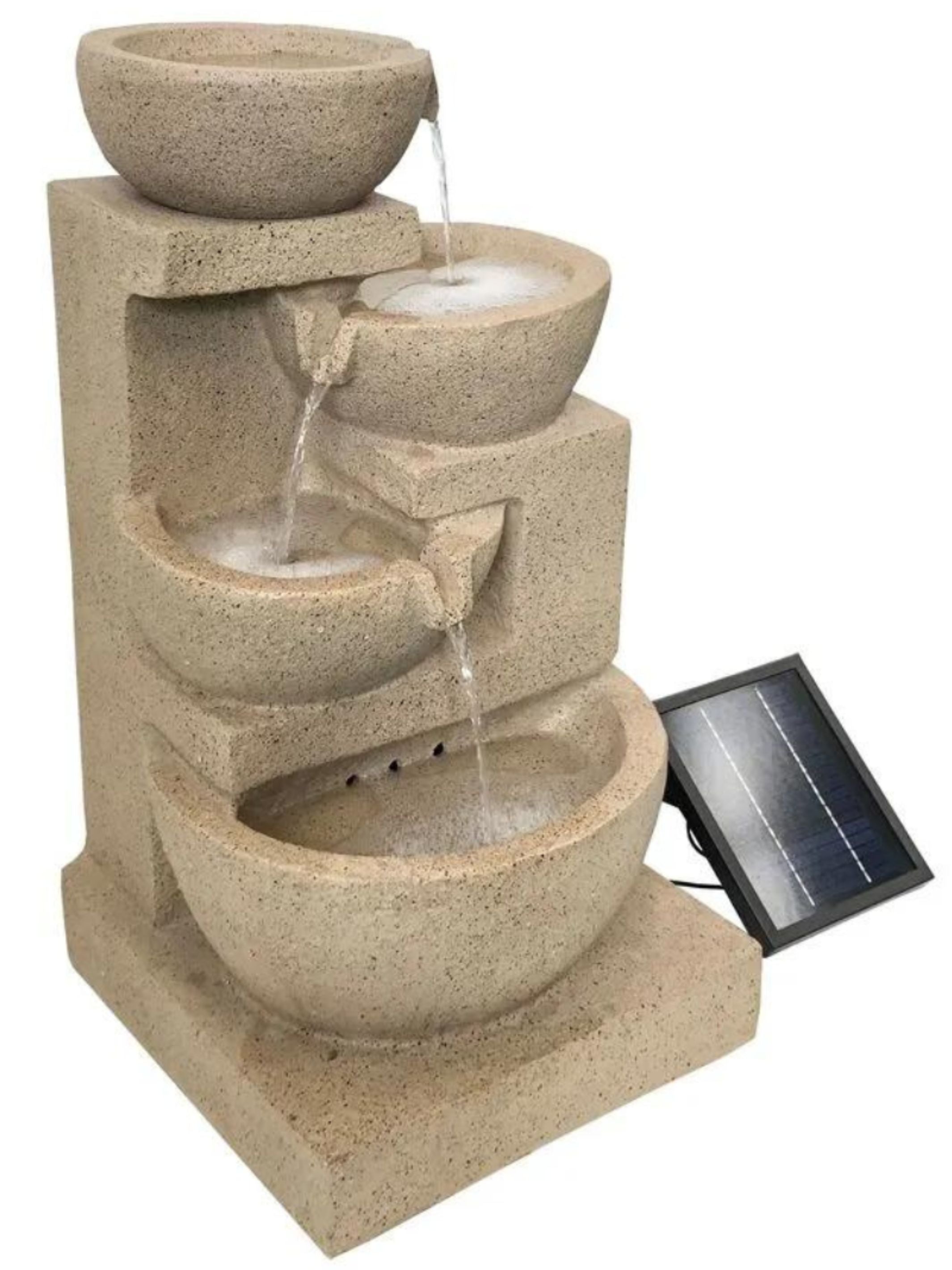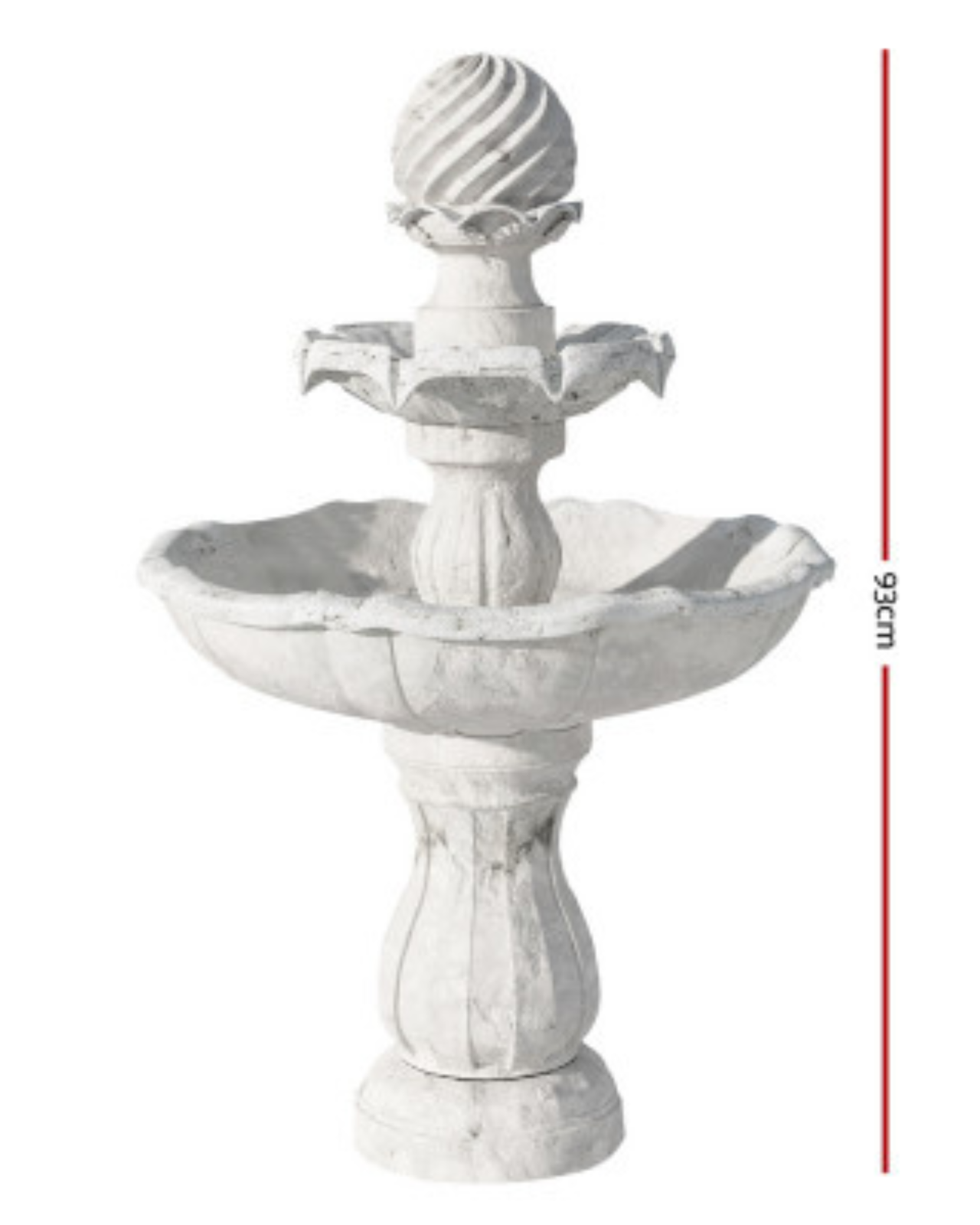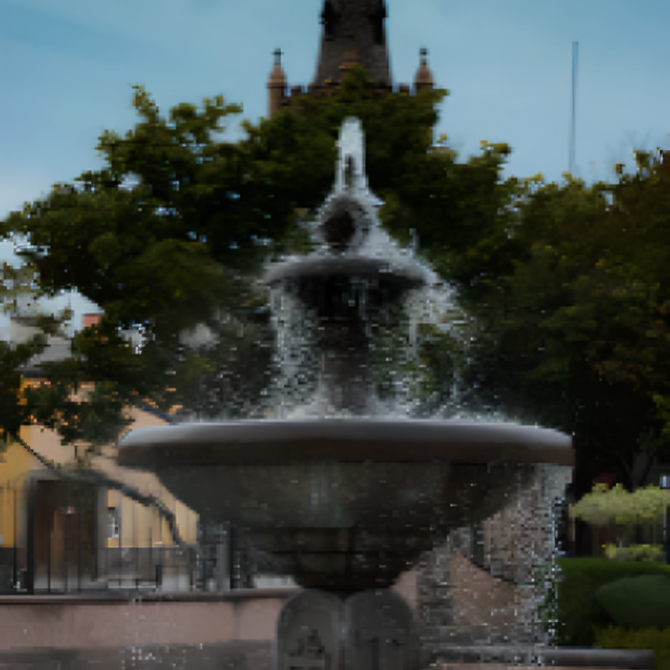Elevate your garden or patio into a sanctuary of elegance and tranquility with our specially selected range of bird bath fountains. At Water Features Adore, we celebrate the serene beauty and captivating charm that a carefully chosen bird bath fountain adds to any outdoor environment. Our collection is thoughtfully curated to introduce a touch of grace and harmony, ensuring that each fountain not only serves as a vital water source for birds but also as a stunning centerpiece for your garden.
Brief Overview of Bird Bath Fountains
Bird bath fountains are charming and functional additions to any garden. They combine the traditional aspects of a birdbath—providing a vital source of water for birds—with the dynamic and aesthetic appeal of a fountain. The gentle movement and sound of water from these fountains not only create a serene atmosphere but also attract a variety of birds. The evolution of these fountains has seen the incorporation of solar powered technology, making
solar bird bath fountains
an increasingly popular choice for environmentally conscious gardeners.
Importance for Birds and Garden Aesthetics
The primary function of a bird bath fountain is to offer birds a place to drink and bathe. Especially in urban areas or during dry spells, these fountains can be crucial for bird survival. From a design perspective, bird bath fountains serve as an enchanting focal point in gardens. They enhance the overall aesthetics by blending natural beauty with artistic design. The sight and sound of water, coupled with the lively presence of birds, can transform an ordinary garden into a tranquil and vibrant haven.
History of Bird Bath Fountains
Evolution from Traditional Bird Baths to Fountains
The concept of bird bath fountains has evolved significantly over time. Originally, bird baths were simple, basin-like structures designed primarily for providing birds with drinking water and a place to bathe. Over the centuries, these utilitarian features evolved into more elaborate designs, incorporating elements of art and nature.
The transition from a static bird bath to a fountain was a natural progression, driven by the desire to enhance the beauty and functionality of these garden features. The introduction of a fountain mechanism added a dynamic element to the bird bath, creating a more inviting and stimulating environment for birds. The sound and sight of moving water not only attracted a wider variety of bird species but also added a soothing acoustic element to gardens.
Incorporation of solar powered technology in recent times has further revolutionized bird bath fountains. This advancement aligns with a growing trend towards sustainability and eco-friendliness in garden design, making solar bird bath fountains an attractive option for modern gardeners.
Historical Significance in Various Cultures
Bird baths and fountains have held significant roles in various cultures throughout history. In ancient civilizations, such as those of Rome and Greece, water features were common in gardens and public spaces, often serving as habitats for birds. These early versions of bird baths were seen not only as practical features for wildlife but also as symbols of prosperity and harmony with nature.
In Eastern cultures, particularly in China and Japan, garden water features, including bird baths, were integral to the philosophical and aesthetic principles of garden design. They were seen as a way to capture the essence of nature, create balance, and provide a meditative focus within the garden space.
During the Victorian era, ornate bird baths and fountains became popular in Europe and America. They were often designed with intricate details and made from materials like cast iron and stone. These structures were considered a status symbol, reflecting a homeowner's taste and their appreciation for nature and wildlife.
Throughout history, bird bath fountains have been more than just a source of water for birds; they have been a reflection of cultural values, artistic expression, and a deep-rooted connection between humans and the natural world.
Types of Bird Bath Fountains
Bird bath fountains come in various types, each offering unique features and fitting different garden styles and needs. Here’s a detailed look at the most common types:
Pedestal Bird Baths
Pedestal bird bath fountains are perhaps the most traditional and widely recognized style. These consist of a bowl mounted on top of a stand or column, elevating the water source above ground level. This height can make birds feel safer from ground predators, encouraging more frequent visits. Pedestal bird baths are often made of materials like stone, concrete, or resin, and can range from simple designs to highly ornate sculptures. They serve as a striking focal point in gardens.
Hanging Bird Baths
Hanging bird baths are a fantastic option for smaller spaces or for adding an aerial element to a garden. These baths are typically suspended from tree branches or hooks, often made from lighter materials like glass, ceramic, or metal. Their elevated position can attract different bird species, particularly those that prefer a higher vantage point. Hanging bird baths sway gently, which can create a captivating visual effect, but also means they usually don’t incorporate fountain features.
Ground-Level Bird Baths
Ground-level bird baths are placed directly on the ground and often blend more naturally with the surrounding environment. They can attract a broader range of wildlife, including birds that naturally forage on the ground, like doves and quails. Ground-level baths can be simple basins or more elaborate designs with integrated fountain features. These types are particularly suitable for creating a naturalistic or wild garden look.
Solar-Powered Fountains
Solar bird bath fountains harness solar energy to power the fountain pump, making them an eco-friendly option. They are typically equipped with a solar panel that either forms part of the design or is placed nearby. These fountains work best in sunny locations and offer the advantage of being wire-free and energy-efficient. Solar-powered fountains are available in various designs, including pedestal, ground-level, and even some hanging models.
Electric Fountains
Electric bird bath fountains are powered by electricity and usually feature a more consistent flow of water compared to their solar-powered counterparts. These fountains require access to an electrical outlet, which can limit their placement but allows for a variety of fountain effects and a more reliable water flow. Electric fountains are often chosen for more formal or structured garden designs and can include a range of styles from traditional to contemporary.
Each type of bird bath fountain offers unique benefits and aesthetic values. Choosing the right type depends on the specific needs of the garden space, the local bird population, and the personal preferences of the gardener.
Materials Used in Bird Bath Fountains
The choice of material for bird bath fountains significantly influences their durability, appearance, and overall impact in a garden setting. Here's a closer look at some common materials used:
Stone
Stone is a classic and popular choice for bird bath fountains. It offers a natural, timeless look that blends seamlessly with outdoor environments. Stone bird baths can range from rugged, natural fieldstone to polished granite or marble, providing options for different aesthetic preferences. Stone is highly durable and can withstand harsh weather conditions, but it is also heavy, which should be considered for installation and placement.
Ceramic
Ceramic bird baths are known for their versatility in design and color. This material allows for a wide range of styles, from rustic, earthy tones to bright, decorative patterns. Ceramic bird baths can be glazed or unglazed, with the former offering more protection against weather elements. While ceramic bird baths are visually appealing, they are more fragile than stone and can crack in freezing temperatures if not properly cared for.
Metal
Metal, including options like cast iron, copper, or stainless steel, is another material commonly used in bird bath fountains. Metal bird baths can range from simple, sleek designs to intricate, ornate styles. They are generally durable and can last for many years with proper maintenance. However, metal bird baths can heat up in direct sunlight, which might discourage birds in warmer climates, and they may require treatment to prevent rust and corrosion.
Resin
Resin is a lightweight, versatile material that is increasingly popular for bird bath fountains. It can be molded into various shapes and styles, often mimicking the appearance of more expensive materials like stone or metal at a lower cost. Resin is weather-resistant and easy to move, making it a good choice for those who like to rearrange their garden setups. However, it may not be as durable as stone or metal in extreme weather conditions.
Glass
Glass bird baths, particularly those used in mosaic designs, offer a unique and artistic touch to gardens. They can be incredibly beautiful, with the glass reflecting sunlight and creating a sparkling effect. Glass bird baths are often used as decorative pieces and can be more fragile than other materials. They require careful placement to avoid damage and may not be suitable for gardens with active wildlife or in areas with harsh weather conditions.
Each of these materials brings its own set of advantages and aesthetic qualities to bird bath fountains, allowing gardeners to choose the perfect match for their garden's theme and their practical needs.
Benefits of Bird Bath Fountains
Attracting a Variety of Birds
One of the primary benefits of bird bath fountains is their ability to attract a diverse range of bird species to your garden. The sound of flowing water is a natural attractant for birds, making fountains more appealing than static bird baths. Different birds are attracted to different types of bird baths and fountain designs, meaning a well-chosen fountain can turn your garden into a haven for a variety of local and migratory bird species.
Aiding Bird Hydration and Cleanliness
Bird bath fountains play a crucial role in providing birds with a reliable source of clean water for drinking and bathing. Hydration is vital for birds, especially in urban areas or during hot, dry weather. Bathing is equally important, as it helps birds maintain their feather health, which is essential for insulation and flight. The moving water in fountains helps keep the water cleaner and fresher than stagnant water, which is beneficial for the health of the birds.
Enhancing Garden Ambiance
Incorporating a bird bath fountain into a garden setting significantly enhances its aesthetic appeal and ambiance. The sight and sound of flowing water add a calming and soothing element to the garden. It can serve as a focal point or complement other features of your outdoor space. Whether it's a minimalist modern design or a classic ornate fountain, it adds a layer of sophistication and charm to the garden.
Eco-friendly Aspects
Solar bird bath fountains offer distinct eco-friendly benefits. By using solar power, they reduce reliance on conventional electricity sources, minimizing the carbon footprint. Solar fountains are especially appealing because they harness renewable energy, making them an environmentally responsible choice. They also offer the advantage of being wire-free, which allows for more flexible placement in the garden and reduces the hassle of dealing with electrical cords.
Bird bath fountains not only provide essential resources for birds but also enhance the aesthetic and ecological aspects of gardens. Their ability to attract diverse birdlife, coupled with the soothing presence of moving water and eco-friendly options, make them a valuable addition to any outdoor space.
Choosing the Right Bird Bath Fountain
When selecting a bird bath fountain for your garden, there are several key factors to consider to ensure that it meets your needs and those of the local bird population. Here's a guide to help you make the best choice:
Factors to Consider (Size, Material, Style)
-
Size: The size of the bird bath fountain should be appropriate for the space available in your garden. Larger gardens can accommodate bigger, more elaborate fountains, while smaller spaces might benefit from a compact or hanging design. Consider the scale in relation to other garden elements and the number of birds you hope to attract.
-
Material: As previously discussed, bird bath fountains are made from various materials like stone, ceramic, metal, resin, and glass, each with its own advantages and aesthetic appeal. Your choice should depend on factors like durability, climate, maintenance requirements, and personal preference in garden decor.
-
Style: The style of the fountain should complement the overall design of your garden. Whether you prefer a modern, minimalist look or a more classic, ornate design, the fountain should integrate well with your garden's theme. Also, consider the type of birds you want to attract; some species may prefer certain styles over others.
Placement Tips for Maximum Attraction and Safety
-
Visibility: Place the fountain where it can be easily seen by birds flying overhead. An open location can make the fountain more attractive to birds.
-
Safety: Ensure the fountain is placed in a spot that is safe from predators. This may mean positioning it away from dense shrubbery where cats or other predators could hide.
-
Sunlight: For solar bird bath fountains, adequate sunlight is crucial. Ensure the fountain is placed in a location that receives ample direct sunlight for optimal functioning.
-
Accessibility: The fountain should be easily accessible for maintenance purposes. Regular cleaning and refilling are essential for the health of the birds and the longevity of the fountain.
Maintenance Considerations
-
Cleaning: Regular cleaning is necessary to keep the water fresh and prevent the growth of algae and bacteria. The frequency of cleaning will depend on the material of the bird bath and the local environment.
-
Winter Care: In colder climates, consider how you will maintain the fountain during winter. Some materials can crack if water freezes in them. Solar-powered and electric fountains may need special considerations during periods of frost or snow.
-
Water Level and Quality: Regularly check and adjust the water level, especially in hot weather or if the fountain is heavily used by birds. Also, consider using a water treatment safe for birds to keep the water clean.
By carefully considering these factors, you can choose a bird bath fountain that not only enhances the beauty of your garden but also provides a safe and attractive environment for birds.
Installation and Maintenance of Bird Bath Fountains
Proper installation and maintenance are key to ensuring that your bird bath fountain is a long-lasting and valuable addition to your garden. Here’s a guide to help you through the process:
Step-by-Step Installation Guide
-
Choose the Location: Select a spot that’s visible to birds, safe from predators, and (if solar-powered) receives ample sunlight.
-
Prepare the Site: Ensure the ground is level. For pedestal bird baths, you may need to lay a stable foundation like a stone slab to prevent tipping.
-
Assemble the Fountain: Follow the manufacturer’s instructions to assemble your bird bath fountain. This often involves attaching the basin to the pedestal and installing the pump.
-
Install the Pump: For electric fountains, place the pump in the basin and run the power cord to an outdoor electrical outlet, ensuring it’s safely away from water. For solar fountains, position the solar panel where it will receive maximum sunlight.
-
Add Water and Test: Fill the basin with water and test the fountain to ensure the pump operates correctly and the water flows smoothly.
-
Final Adjustments: Make any necessary adjustments to the water flow and check that the fountain is stable and level.
Cleaning and Care Tips
-
Regular Cleaning: Clean the basin and pump regularly to prevent algae growth and ensure the water is clean. This typically involves scrubbing the basin with a brush and mild soap, then rinsing thoroughly.
-
Pump Maintenance: Regularly check and clean the pump according to the manufacturer's instructions. This may involve disassembling the pump to remove debris and buildup.
-
Water Quality: Change the water frequently, especially in hot weather, to keep it fresh and clean. Avoid using harsh chemicals or cleaners that could harm birds.
-
Inspect Regularly: Periodically inspect your fountain for cracks, leaks, or any signs of wear and tear. Promptly repair any damage to prevent further deterioration.
Winter Care for Bird Bath Fountains
-
Freezing Temperatures: In areas with freezing temperatures, it’s important to protect your fountain from ice damage. If your bird bath is made of a material that can crack (like ceramic), it’s best to empty it and store it in a shed or garage during the winter months.
-
Heating Elements: For those who want to provide birds with water year-round, consider adding a heating element to your bird bath to prevent the water from freezing.
-
Solar and Electric Fountains: Solar panels may not function effectively in the winter due to reduced sunlight. Electric fountains should be carefully managed to prevent electrical hazards in wet conditions.
-
Regular Checks: Continue to check and clean the bird bath throughout the winter, ensuring that it remains a safe and accessible water source for birds.
By following these installation and maintenance guidelines, you can enjoy the beauty and benefits of your bird bath fountain throughout the year, while providing a vital resource for your local bird population.
Common Problems and Solutions for Bird Bath Fountains
Algae Growth
Algae growth is a common issue in bird bath fountains, particularly during warm weather. Algae can make the water unhealthy for birds and clog the fountain's pump.
-
Regular Cleaning: Regularly clean the bird bath and change the water. Scrubbing the basin with a brush and mild, environmentally-safe soap can prevent algae buildup.
-
Water Treatment: Use a bird-safe algaecide or natural remedies like barley straw to control algae growth. Avoid chemicals that could be harmful to birds or other wildlife.
-
Shade Placement: Consider placing your bird bath in a location where it receives some shade during the day, as direct sunlight accelerates algae growth.
-
Circulation: Ensure the water is circulating properly, as stagnant water is more prone to algae. Adjust the pump as needed to maintain good water movement.
Water Pump Issues
Water pumps are essential for the operation of bird bath fountains but can sometimes encounter issues.
-
Regular Maintenance: Clean the pump regularly following the manufacturer's instructions. Remove any debris or buildup that could impede its function.
-
Check Power Supply: For electric pumps, ensure the power supply is consistent and safe. For solar pumps, make sure the solar panel is not obstructed and receives enough sunlight.
-
Water Level: Low water levels can cause the pump to run dry and overheat. Ensure the fountain always has enough water.
-
Replacement Parts: If a pump is not working despite troubleshooting, consider replacing worn parts or the entire pump.
Weather-Related Damage
Bird bath fountains can be susceptible to weather-related damage, such as cracking in cold weather or fading from sun exposure.
-
Winter Protection: In freezing climates, empty and cover stone or ceramic bird baths, or bring them indoors. Consider using a bird bath heater to prevent freezing.
-
Material Choice: Choose materials that are suitable for your local climate. For example, resin or metal might be more durable in areas with harsh winters.
-
Secure Installation: Ensure your bird bath is securely installed to prevent tipping or damage during strong winds or storms.
-
Sun Protection: For bird baths made of materials susceptible to sun damage, position them in a location where they receive some shade during the hottest part of the day.
By addressing these common problems with appropriate solutions, you can ensure that your bird bath fountain remains a beautiful and functional part of your garden for years to come.
Joys of Bird Bath Fountains
Connection with Nature
One of the most significant joys of having a bird bath fountain in your garden is the connection it fosters with nature. Watching a variety of birds flit in and out, enjoying the water, and listening to their songs creates a sense of peace and contentment. It's a simple yet profound way to engage with the natural world right in your own backyard.
Wildlife Habitat Support
Bird bath fountains play a crucial role in supporting local wildlife, especially in urban areas where natural water sources may be scarce. By providing birds with a consistent source of water for drinking and bathing, these fountains help maintain the health and well-being of the bird population. This, in turn, contributes to the ecological balance in your area.
Aesthetic Enhancement
A well-chosen bird bath fountain can significantly enhance the aesthetic appeal of a garden. Whether it’s a classic stone design, a whimsical resin model, or a sleek modern piece, a bird bath fountain can serve as a focal point and add an element of elegance and charm to your outdoor space.
Relaxation and Stress Reduction
The sound of flowing water from a fountain is universally recognized for its calming properties. Having a bird bath fountain in your garden can create a tranquil oasis where you can unwind and de-stress. It’s a perfect spot for meditation, reading, or simply enjoying a quiet moment.
Educational Value
For families with children, a bird bath fountain offers educational opportunities. It can be used to teach kids about different bird species, their behaviors, and the importance of conserving and supporting wildlife. It's an interactive way to learn about nature and the environment.
Encouraging Biodiversity
Bird bath fountains attract not only birds but also other beneficial wildlife like butterflies and bees. This helps to increase biodiversity in your garden, leading to a healthier and more balanced ecosystem.
Eco-Friendly Aspects
Especially with the use of solar bird bath fountains, there’s an added benefit of being eco-friendly. Using renewable energy to power the fountain reduces your carbon footprint and promotes a sustainable approach to garden design.
Bird bath fountains offer a range of joys and benefits, from enhancing garden beauty to supporting wildlife and providing a peaceful retreat. They are a simple yet effective way to bring more life and tranquility into your outdoor space.
Integrating Bird Bath Fountains with Other Garden Features
Complementing Garden Statues
Bird bath fountains can be beautifully integrated with
garden statues
to create a cohesive and elegant outdoor space. Positioning a bird bath near a statue can draw attention to both features, creating a picturesque scene in your garden. For instance, a classical statue next to a similarly styled bird bath can evoke a sense of a traditional garden, while a modern sculpture alongside a sleek fountain design can enhance a contemporary garden setting.
Pairing with Water Feature Urns
Water feature urns, known for their decorative and sculptural qualities, can be paired effectively with bird bath fountains. Placing a bird bath fountain near a water feature urn creates a harmonious flow of water elements throughout the garden. The urn's shape and texture can complement the bird bath, providing visual interest and continuity in design.
Integrating with Water Features and Ponds
Bird bath fountains can also be integrated seamlessly with existing
water features
and
ponds
. Adding a bird bath near a pond not only provides an additional water source for birds but also adds height and movement to the water landscape. This can create a multi-tiered effect, with the pond serving as a habitat for aquatic life and the bird bath attracting airborne wildlife. The sound of the fountain can enhance the overall ambiance of the water feature, making it a more dynamic and engaging part of your garden.
Creating a Water-Themed Garden
For gardens focusing on water as a central theme, combining bird bath fountains with various water features like ponds, urns, and statues can create a cohesive and tranquil garden experience. This setup can turn a simple garden into a serene retreat, filled with the soothing sounds of flowing water and the vibrant activity of visiting wildlife.
In summary, creatively integrating bird bath fountains with other garden features like statues, water feature urns, and ponds can enhance the overall aesthetic and thematic consistency of your garden. It’s an effective way to create a dynamic and harmonious outdoor space that is both visually appealing and beneficial for local wildlife.
Premier Bird Bath Fountain Choices at Water Features Adore
Drizzle - 3 Tier Bird Bath Water Feature
The Drizzle - 3 Tier Bird Bath Water Feature is a standout choice for gardeners seeking a combination of elegance and functionality. This fountain features three gracefully arranged tiers that allow water to cascade gently from one level to the next, creating a soothing sound and visual appeal. Its traditional design makes it a perfect centerpiece for classic garden themes.
Rill - Solar 3 Tier Bird Bath Lighting Water Feature Fountain
The Rill - Solar 3 Tier Bird Bath Lighting Water Feature Fountain offers an eco-friendly and visually stunning addition to any garden. This solar-powered fountain not only provides the usual benefits of a bird bath but also includes lighting, enhancing its beauty at dusk and night. The three-tiered design ensures ample water movement, attracting a variety of birds.
Qui - Solar 2 Tier Lighting Bird Bath Water Feature Fountain
For those who prefer a more compact design, the Qui - Solar 2 Tier Lighting Bird Bath Water Feature Fountain
is an excellent choice. It combines the practicality of a solar-powered fountain with the aesthetic appeal of a two-tiered structure. The integrated lighting feature adds a charming glow, making it a focal point in your garden both day and night.


